A marketing plan outlines the strategies and tactics a company will use to promote its products or services. It helps guide marketing efforts to achieve business goals.
A basic plan includes identifying target markets, defining objectives, developing strategies, and outlining budgets and timelines. Components of a thorough marketing plan cover situation analysis, objectives, positioning, messaging, budget allocation, measurement, and oversight.
There are strategic plans outlining long-term efforts and tactical plans detailing specific actions. An effective marketing plan is essential for businesses to connect with customers, grow revenue, and compete in their industry. To succeed, a plan must have buy-in across the organization, adapt to market changes, and translate strategy into measurable results.
Components Of The Marketing Plan
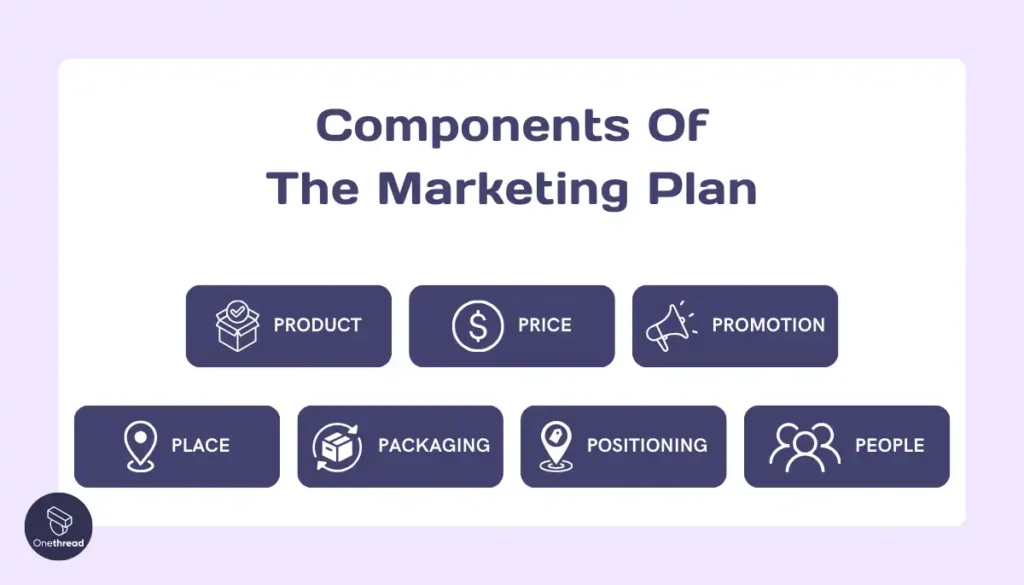
The core components of a marketing plan can be remembered as the 7 Ps: Product, Price, Promotion, Place, Packaging, Positioning, and People. Each component plays a vital role in ensuring the success of a marketing strategy.
Product
Product refers to what your business offers to the market, which can be either a tangible good or an intangible service that fulfills a need or desire of consumers. When focusing on the product, consider its key features, benefits, and the problem it solves for the customer.
It’s also important to think about the lifecycle of the product, any potential for future development, and how it differs from competitors.
Price
Price is the amount of money customers must pay to acquire your product. Pricing strategies are crucial as they affect demand, profitability, and market positioning.
Factors to consider include production and operational costs (which can be better tracked using the best accounting software for small business), competitor pricing, perceived value by the customer, and pricing methods (e.g., cost-plus, value-based, or competitive pricing).
Promotion
Promotion encompasses all the ways you tell your customers about your products or services and how you then sell to them.
To enhance communication with customers, integrating SMS AI solutions can help deliver personalized and timely messages, improving engagement and conversion rates in your marketing efforts.
This can include advertising, sales promotions, direct marketing, social media marketing, and public relations.
The key is to understand your target audience and design a promotion strategy that effectively communicates the benefits and features of your product.
Place
Place, also known as distribution, involves making your product available to the target market at the right time, location, and quantity. This includes selecting appropriate distribution channels (e.g., online, retail, direct sales) and logistics planning to ensure products are easily accessible to customers when they are ready to buy.
Packaging
Packaging is not just about physically wrapping your product; it’s also about the first impression it gives.
Effective packaging can attract customers, offer convenience, and communicate the brand’s message. It should be designed considering functionality, aesthetic appeal, and environmental impact.
Positioning
Positioning refers to how your product is perceived by the target market in relation to your competitors. It’s about carving out a unique space in the market and in the minds of consumers that differentiates your product from competitors.
Effective positioning is achieved through a combination of the other P’s, particularly product features, price, and promotion.
People
People are a crucial element of any marketing plan, encompassing everyone involved in the production, promotion, and sale of the product, as well as customer service.
Employees should be trained to ensure their performance aligns with the brand’s values and promises. Additionally, understanding the target audience’s demographics, needs, and preferences is essential for tailoring marketing strategies.
Essentially, it serves as a roadmap for a company’s marketing efforts, aligning marketing activities with business goals to effectively promote products or services.
Types of Marketing Plans
When creating a strategic marketing plan, there are several common approaches:
Product Marketing Plan
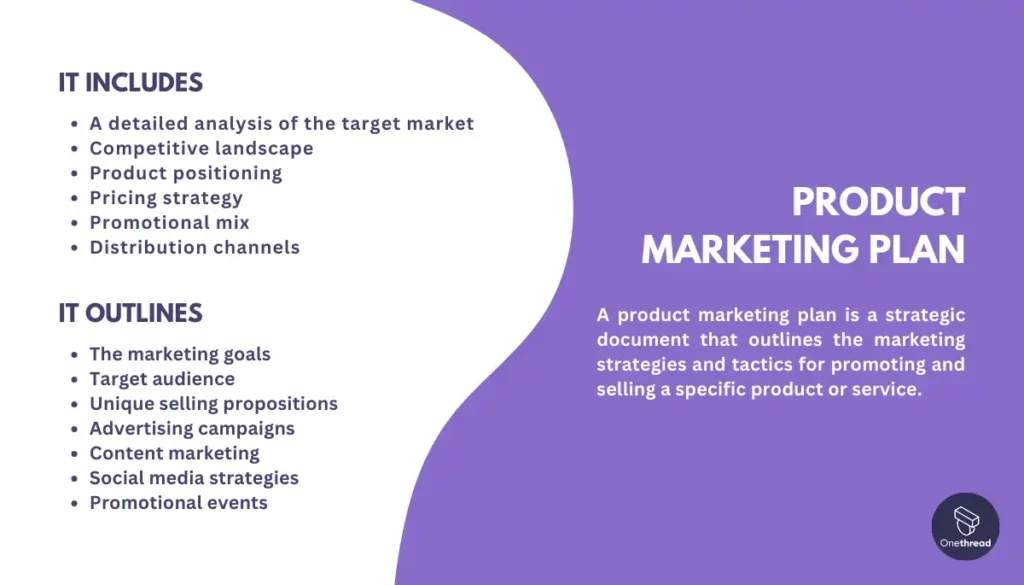
A product marketing plan is a strategic document that outlines the marketing strategies and tactics for promoting and selling a specific product or service.
A product marketing plan typically includes a detailed analysis of the target market, competitive landscape, product positioning, pricing strategy, promotional mix, and distribution channels.
It outlines the marketing goals, target audience, unique selling propositions, and the specific tactics to be employed, such as advertising campaigns, content marketing, social media strategies, and promotional events.
Promoting a unique product often necessitates specialized tools that can streamline and enhance marketing strategies. By utilizing Angular data grid and spreadsheet components, businesses can better manage information flow and execute functions crucial for achieving marketing objectives.
These components enable efficient data manipulation, serving as an integral part of any product marketing plan geared towards detailed analysis and customer engagement.
Who Should Create This Plan And Why?
A product marketing plan should be created by product marketing teams or product managers within a company. The plan is essential for ensuring the successful launch, positioning, and ongoing promotion of a product. It helps align the marketing efforts with the product’s unique features, target audience, and business goals.
Who Shouldn’t Create This Plan And Why?
Companies or individuals that do not have a specific product or service to market should not create a product marketing plan. It is a specialized document tailored to a particular offering and is not applicable to general marketing or branding efforts.
Social Media Marketing Plan
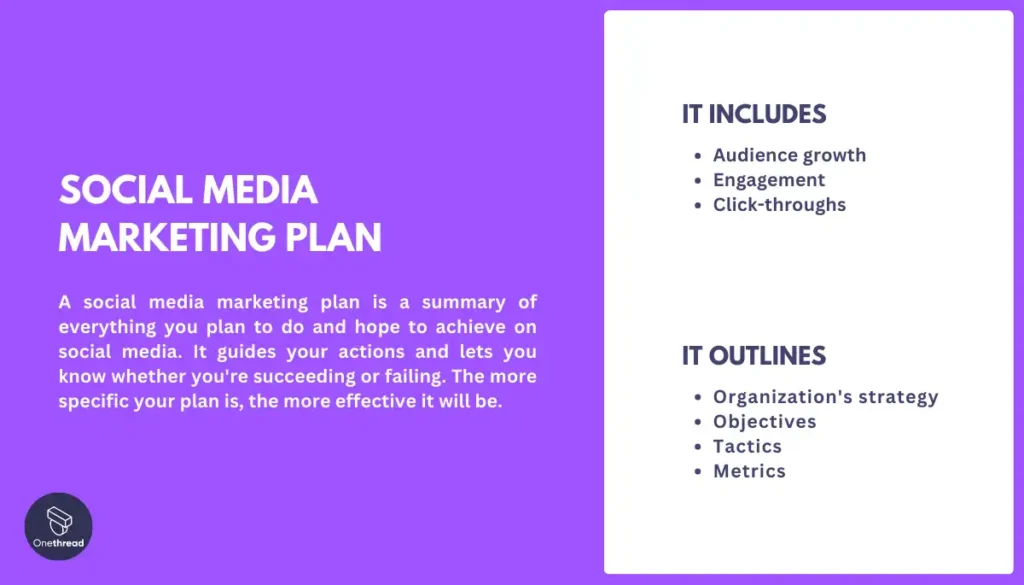
A social media marketing plan outlines an organization’s strategy, objectives, tactics, and metrics for leveraging social platforms to increase brand awareness, website traffic, lead generation, and sales. It identifies target buyer personas and documents the optimal social media channels to engage them.
A sound plan establishes posting schedules and assigns responsibilities while setting benchmarks for social media KPIs like audience growth, engagement, and click-throughs. Overall, the plan works to boost marketing ROI via social.
Who Should Create This Plan And Why?
Any business actively utilizing social platforms as a marketing channel should create a social media marketing plan. It ensures strategic alignment on social goals across teams and more effective campaign execution. With clear documentation of target audiences, positioning, channel mix, resources, and metrics, a plan maximizes ROI.
Who Shouldn’t Create This Plan And Why?
Businesses just starting out on social media may not need an in-depth plan if still experimenting to identify ideal platforms, content, and audiences. Similarly, a business with just a Twitter or Facebook profile for basic announcements won’t require a complex plan. But lacking strategy and intentionality, social media efforts risk poor engagement and results.
Content Marketing Plan
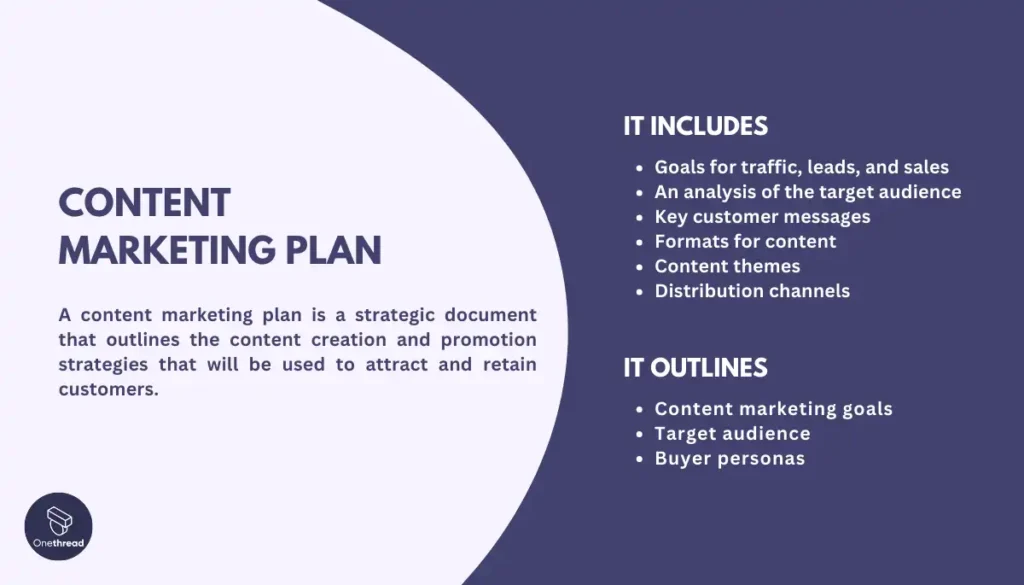
A content marketing plan is a strategic document that outlines the content creation and promotion strategies that will be used to attract and retain customers.
The content marketing plan includes goals for traffic, leads, and sales, an analysis of the target audience, key customer messages, formats for content, content themes, and distribution channels.
It outlines the overall content marketing goals, target audience and buyer personas, unique value propositions conveyed in the content, specific content formats that will be leveraged, overarching content themes and focus areas, and the channels used to distribute content to reach and engage customers.
Who Should Create This Plan And Why?
Businesses aiming to build a long-term relationship with their audience should create a content marketing plan. This includes companies with a clear understanding of their audience’s needs and interests.
Content marketing is vital for those wanting to establish authority in their industry, improve search engine rankings, and drive inbound leads. Additionally, for effective lead management, it’s important to know how to export leads from Sales Navigator for seamless integration into your CRM and marketing strategies.
If your target audience is from London, using a content marketing agency in the UK is a key way to attract specific clientele.
Businesses looking for quick sales or those without the resources to consistently produce quality content should not create a content marketing plan. If a company can’t commit to regular content creation or lacks a clear strategy for engaging its target audience, content marketing may not yield the desired results.
Email Marketing Plan
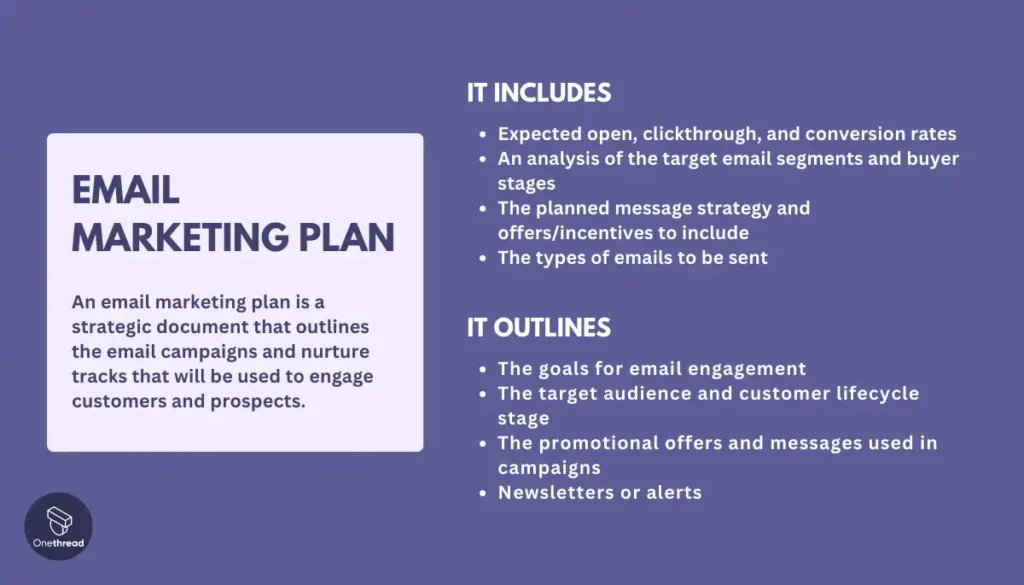
An email marketing plan is a strategic document that outlines the email campaigns and nurture tracks that will be used to engage customers and prospects.
The email marketing plan includes expected open, clickthrough, and conversion rates, an analysis of the target email segments and buyer stages, the planned message strategy and offers/incentives to include, and the types of emails to be sent. The email marketing plan also integrates Snov.io to streamline lead generation, email verification, and outreach automation, ensuring higher accuracy and efficiency in campaign execution.
It outlines the goals for email engagement, the target audience and customer lifecycle stage, the promotional offers and messages used in campaigns, the specific email formats to use such as newsletters or alerts, personalization approaches to improve relevancy, and exporting prospects from Sales Navigator to find more leads.
Who Should Create This Marketing Plan And Why?
Businesses with an existing customer base or those building an email list should utilize CRM and email marketing. It’s crucial for companies looking to directly communicate offers, updates, and content to their audience, fostering loyalty and repeat business.
However, companies should know how to configure DMARC to protect their brand from email spoofing and ensure that their messages reach the intended recipients securely.
Who Shouldn’t Create This Marketing Plan And Why?
Businesses without the capability to collect and manage an email list, or those in industries where email communication is less effective, should reconsider. If you cannot commit to producing regular, valuable content, email marketing may not yield the desired results.
Direct Marketing Plan
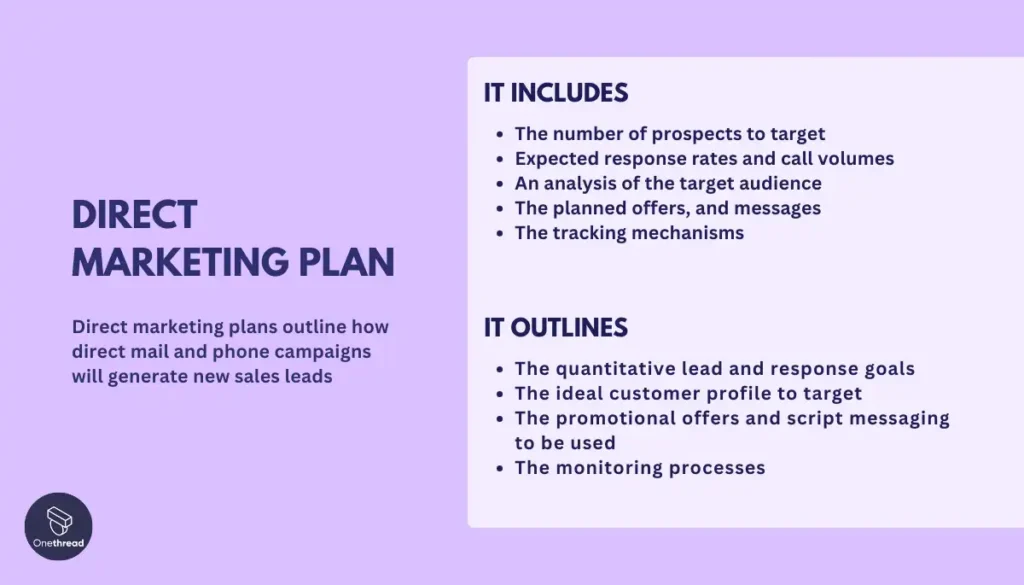
Direct marketing plans outline how direct mail and phone campaigns will generate new sales leads
The direct marketing plan includes the number of prospects to target, expected response rates and call volumes, an analysis of the target audience, the planned offers, and messages, and the tracking mechanisms to monitor results.
It outlines the quantitative lead and response goals, the ideal customer profile to target, the promotional offers and script messaging to be used, and the monitoring processes to continually refine direct marketing campaigns.
Who Should Create This Marketing Plan And Why?
Companies with access to customer data and the ability to personalize communication should employ direct marketing. It’s ideal for businesses seeking measurable responses from targeted marketing campaigns.
Who Shouldn’t Create This Marketing Plan And Why?
Businesses lacking direct access to customer data or those in sectors where personalization is challenging may find direct marketing less effective. It requires a significant investment in data management and campaign tracking.
Buzz Marketing Plan
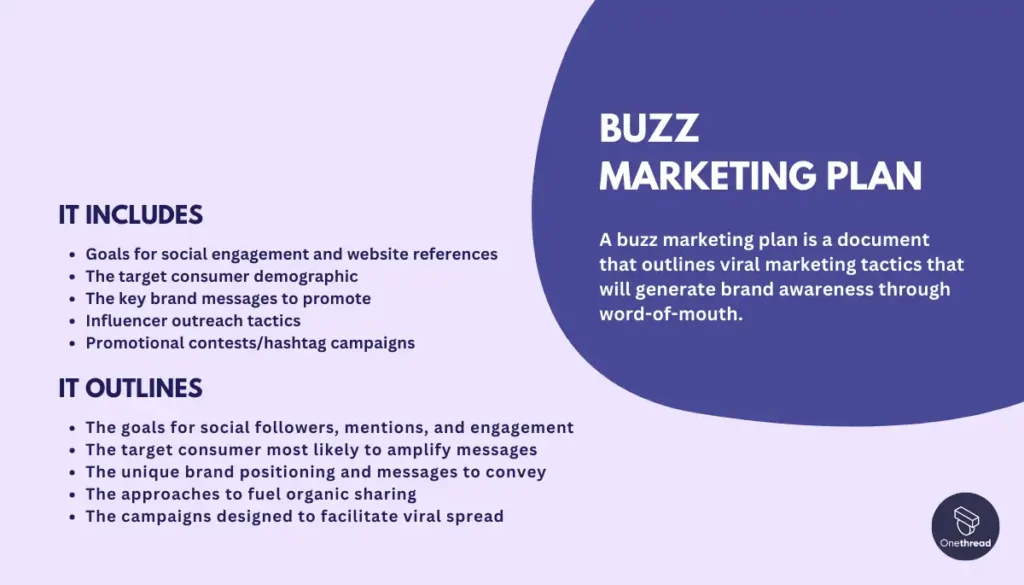
A buzz marketing plan is a document that outlines viral marketing tactics that will generate brand awareness through word-of-mouth.
The buzz marketing plan includes goals for social engagement and website references, the target consumer demographic, the key brand messages to promote, influencer outreach tactics, and promotional contests/hashtag campaigns.
It outlines the goals for social followers, mentions, and engagement, the target consumer most likely to amplify messages, the unique brand positioning and messages to convey, the approaches to fuel organic sharing, and the campaigns designed to facilitate viral spread.
Who Should Create This Marketing Plan And Why?
Brands with unique, innovative, or highly appealing products that can naturally generate public interest and conversation should implement buzz marketing. It’s particularly effective for launches or special promotions aiming to quickly elevate brand visibility and engagement.
Who Shouldn’t Create This Marketing Plan And Why?
Companies with products or services that lack novelty or a compelling angle may struggle to generate buzz. Additionally, businesses not prepared to handle rapid public response or those lacking in social media savviness should approach with caution, as buzz marketing requires active engagement and monitoring.
Cause Marketing Plan
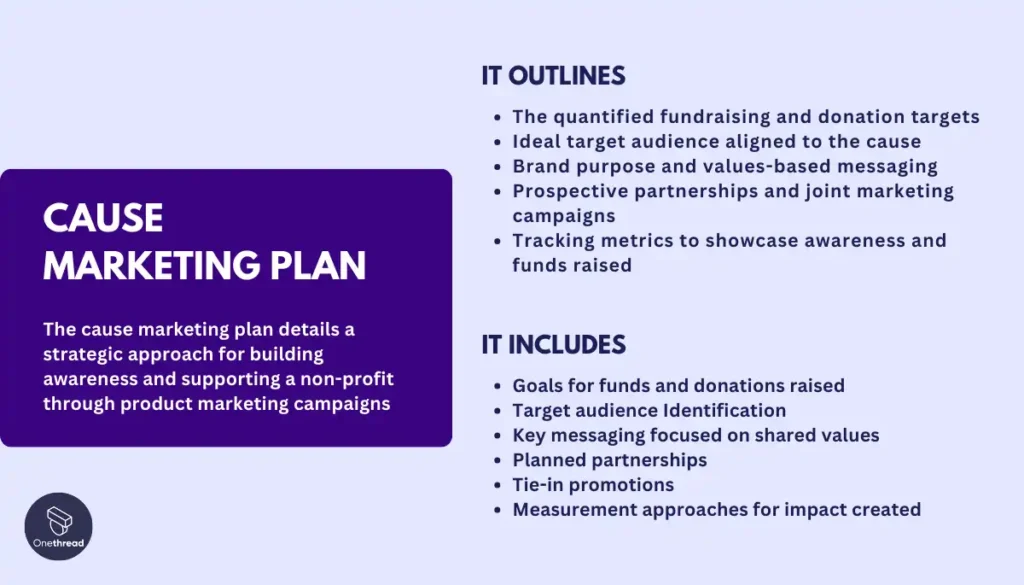
The cause marketing plan details a strategic approach for building awareness and supporting a non-profit through product marketing campaigns.
It includes goals for funds and donations raised, target audience Identification, key messaging focused on shared values, planned partnerships, tie-in promotions, and measurement approaches for impact created.
The cause marketing plan outlines the quantified fundraising and donation targets, ideal target audience aligned to the cause, brand purpose and values-based messaging, prospective partnerships and joint marketing campaigns, and tracking metrics to showcase awareness and funds raised.
Who Should Create This Marketing Plan And Why?
Businesses committed to social responsibility and looking to build a brand that resonates on a deeper level with their audience should engage in cause marketing. It’s suitable for companies seeking to enhance their brand image, customer loyalty, and community impact.
Who Shouldn’t Create This Marketing Plan And Why?
Businesses without a genuine commitment to social causes or those unable to authentically integrate social issues into their brand narrative should avoid cause marketing. Inauthentic campaigns can lead to public backlash and damage brand reputation.
Digital Marketing Plan
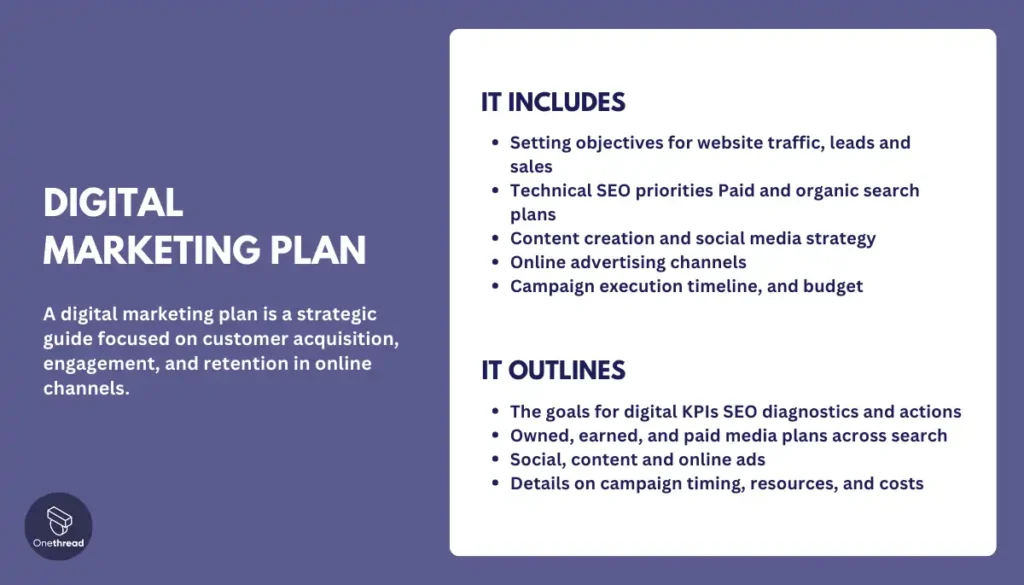
A digital marketing plan is a strategic guide focused on customer acquisition, engagement, and retention in online channels, including Bulk SMS. It encompasses setting objectives for website traffic, leads and sales, technical SEO priorities, local SEO via local citation finder, paid and organic search plans, content creation, social media strategy, bulk sms, online advertising channels, campaign execution timeline, and budget.
The digital marketing plan maps out the goals for digital KPIs, SEO diagnostics and actions, owned, earned, and paid media plans across search, social, content and online ads, and details on campaign timing, resources, and costs.
Who Should Create This Marketing Plan And Why?
Every business aiming to establish or expand its online presence should develop a digital marketing plan. It’s essential for reaching today’s digitally savvy consumers, increasing brand awareness, and driving online sales or leads.
For SaaS companies, partnering with the top SaaS SEO agency can be a strategic move to enhance visibility and outpace competitors
Who Shouldn’t Create This Marketing Plan And Why?
Companies without the resources to consistently execute and manage digital campaigns across multiple channels might not benefit as much from a digital marketing plan. Additionally, businesses targeting a demographic less active online may need to prioritize other marketing strategies.
Growth Marketing Plan
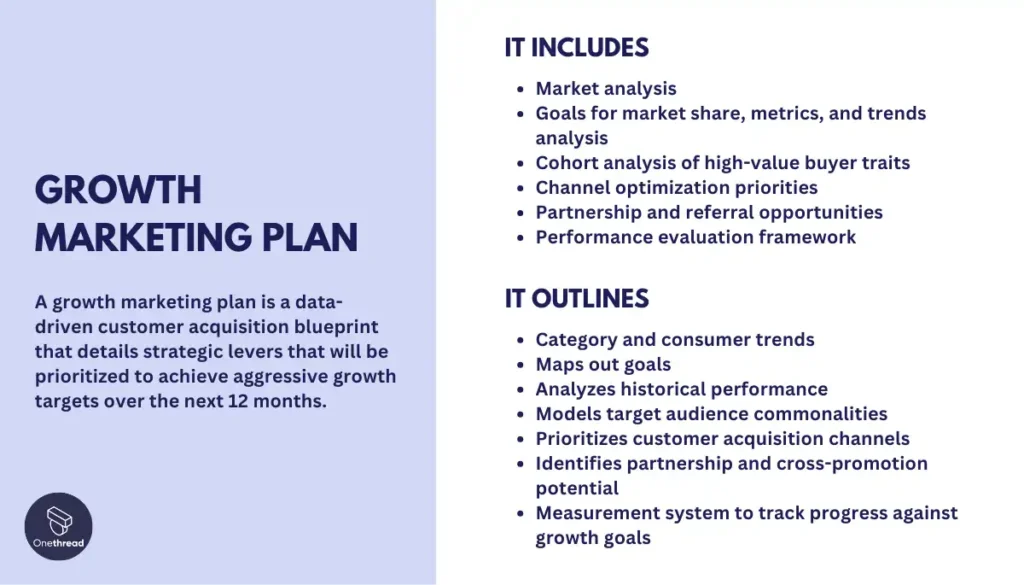
A growth marketing plan is a data-driven customer acquisition blueprint that details strategic levers that will be prioritized to achieve aggressive growth targets over the next 12 months.
It includes market analysis, goals for market share, metrics, and trends analysis, cohort analysis of high-value buyer traits, channel optimization priorities, partnership and referral opportunities, and a performance evaluation framework.
The growth marketing plan dissects category and consumer trends, maps out goals, analyzes historical performance, models target audience commonalities, prioritizes customer acquisition channels, identifies partnership and cross-promotion potential, and outlines a measurement system to track progress against growth goals.
Who Should Create This Marketing Plan And Why?
Startups and businesses looking for aggressive growth should adopt growth marketing. It’s crucial for companies aiming to quickly discover scalable marketing strategies and product improvements that drive user acquisition and retention.
Who Shouldn’t Create This Marketing Plan And Why?
Businesses with limited capacity for rapid experimentation or those in highly regulated industries where rapid changes could pose compliance risks may find growth marketing challenging. It requires a culture of innovation and flexibility not all organizations possess.
Relationship Marketing Plan
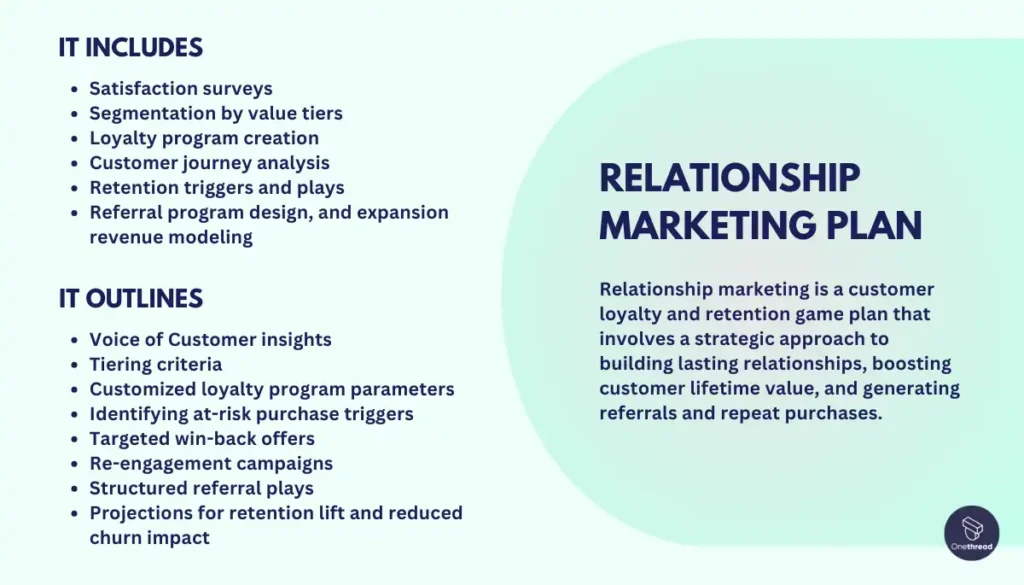
Relationship marketing is a customer loyalty and retention game plan that involves a strategic approach to building lasting relationships, boosting customer lifetime value, and generating referrals and repeat purchases.
It encompasses satisfaction surveys, segmentation by value tiers, loyalty program creation, customer journey analysis, retention triggers and plays, referral program design, and expansion revenue modeling.
The plan outlines Voice of Customer insights, tiering criteria, customized loyalty program parameters, identifying at-risk purchase triggers, targeted win-back offers and re-engagement campaigns, structured referral plays, and projections for retention lift and reduced churn impact.
Who Should Create This Marketing Plan And Why?
Businesses aiming to increase customer lifetime value and foster loyalty should implement a relationship marketing plan. It’s essential for companies that rely on repeat business and referrals, such as service providers, subscription-based models, and high-value product sellers.
Who Shouldn’t Create This Marketing Plan And Why?
Companies looking for quick sales without the intention to invest in ongoing customer relationships may not benefit from this approach. If resources are limited and the focus is on short-term growth, relationship marketing might not align with business goals.
Marketing Launch Plan
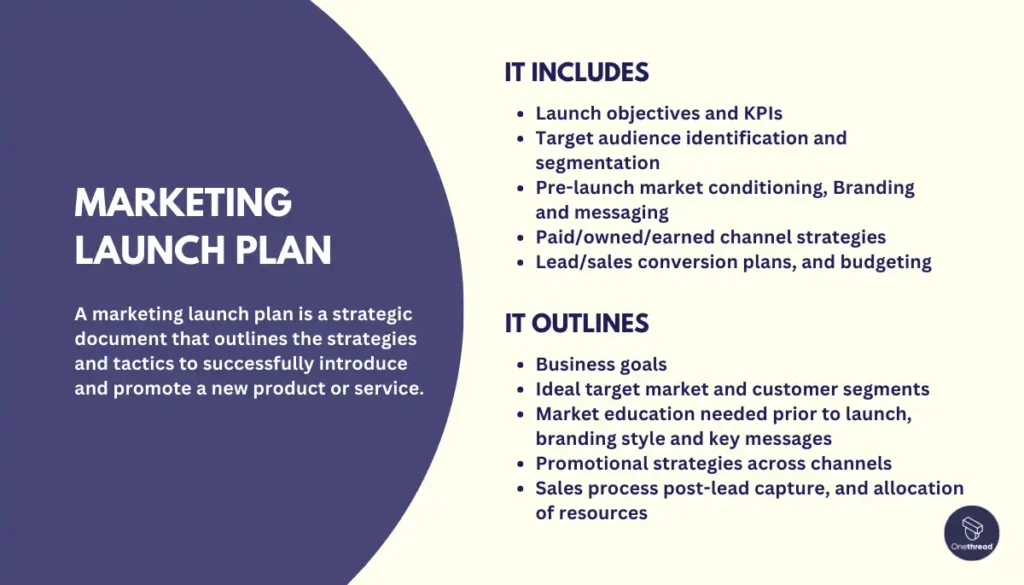
A marketing launch plan is a strategic document that outlines the strategies and tactics to successfully introduce and promote a new product or service.
The marketing launch plan includes launch objectives and KPIs, target audience identification and segmentation, pre-launch market conditioning, launch creative such as branding and messaging, paid/owned/earned channel strategies, lead/sales conversion plans, and budgeting.
It outlines the business goals, ideal target market and customer segments, market education needed prior to launch, branding style and key messages, promotional strategies across channels, sales process post-lead capture, and allocation of resources.
Who Should Create This Marketing Plan And Why?
Any business launching a new product or entering a new market should have a marketing launch plan. It’s crucial for creating buzz, ensuring a coordinated launch across all channels, and achieving early adoption goals.
Who Shouldn’t Create This Marketing Plan And Why?
Companies not ready to fully support a new product launch, whether due to budget constraints, market conditions, or internal readiness, should delay creating a launch plan. A premature or underfunded launch can harm the product’s market entry and long-term success.
PR Marketing Plan
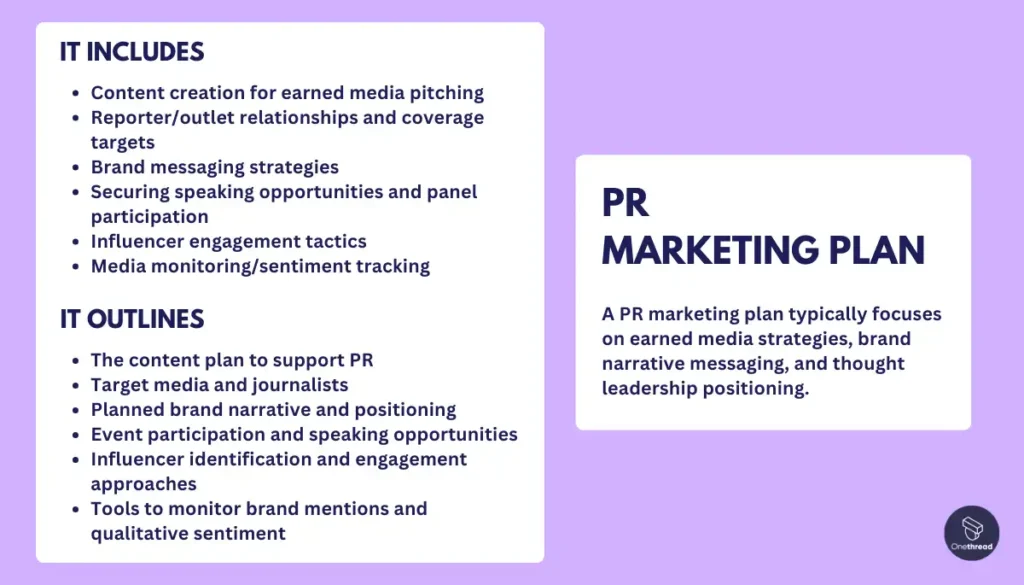
A PR marketing plan typically focuses on earned media strategies, brand narrative messaging, and thought leadership positioning.
The PR marketing plan includes content creation for earned media pitching, reporter/outlet relationships and coverage targets, brand messaging strategies, securing speaking opportunities and panel participation, influencer engagement tactics, and media monitoring/sentiment tracking.
It outlines the content plan to support PR, target media and journalists, planned brand narrative and positioning, event participation and speaking opportunities, influencer identification and engagement approaches, and tools to monitor brand mentions and qualitative sentiment.
Who Should Create This Marketing Plan And Why?
Organizations that rely on public perception, need to build or repair their reputation or want to establish thought leadership in their industry should develop a PR marketing plan. It’s essential for managing how the brand is perceived and engaging with the media and public.
Who Shouldn’t Create This Marketing Plan And Why?
Businesses without newsworthy stories or those that operate in industries where public opinion has minimal impact on purchasing decisions may find a PR marketing plan less critical. If resources are limited, focusing on direct marketing efforts might yield a higher ROI.
Brand Marketing Plan
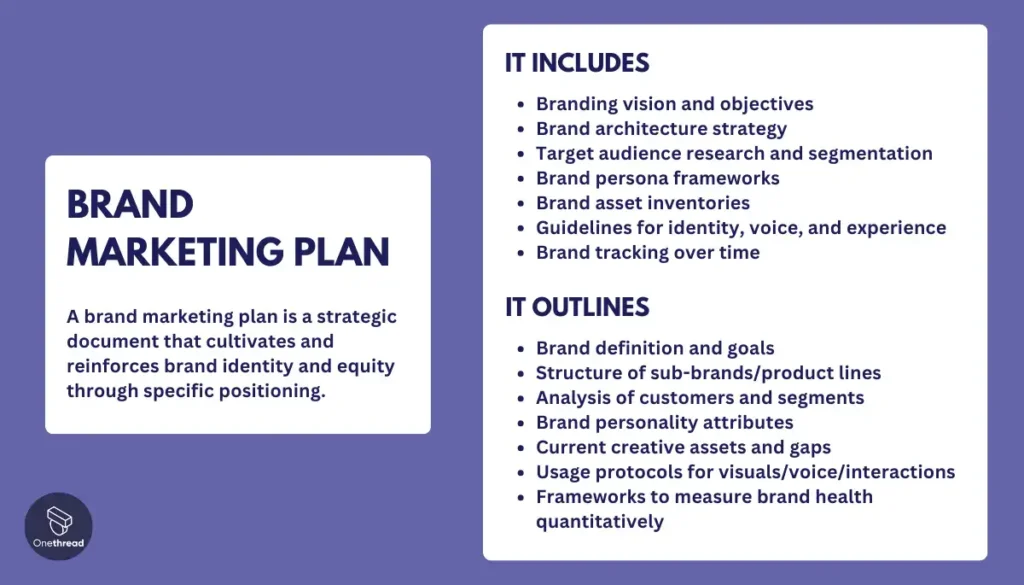
A brand marketing plan is a strategic document that cultivates and reinforces brand identity and equity through specific positioning.
The brand marketing plan includes branding vision and objectives, brand architecture strategy, target audience research and segmentation, brand persona frameworks, brand asset inventories, guidelines for identity, voice, and experience, and brand tracking over time.
It outlines the brand definition and goals, structure of sub-brands/product lines, analysis of customers and segments, brand personality attributes, current creative assets and gaps, usage protocols for visuals/voice/interactions, and frameworks to measure brand health quantitatively.
Who Should Create This Marketing Plan And Why?
Companies seeking to establish a strong, recognizable brand or rebrand to better align with their audience’s values should implement a brand marketing plan. It’s crucial for businesses aiming to build loyalty, justify premium pricing, and create an emotional connection with customers.
Who Shouldn’t Create This Marketing Plan And Why?
Businesses that operate in highly commoditized markets with little differentiation or those not ready to invest in long-term brand building may find brand marketing less effective. If immediate sales and lead generation are priorities over brand affinity, focusing on direct marketing tactics might be more beneficial.
Conversational Marketing Plan
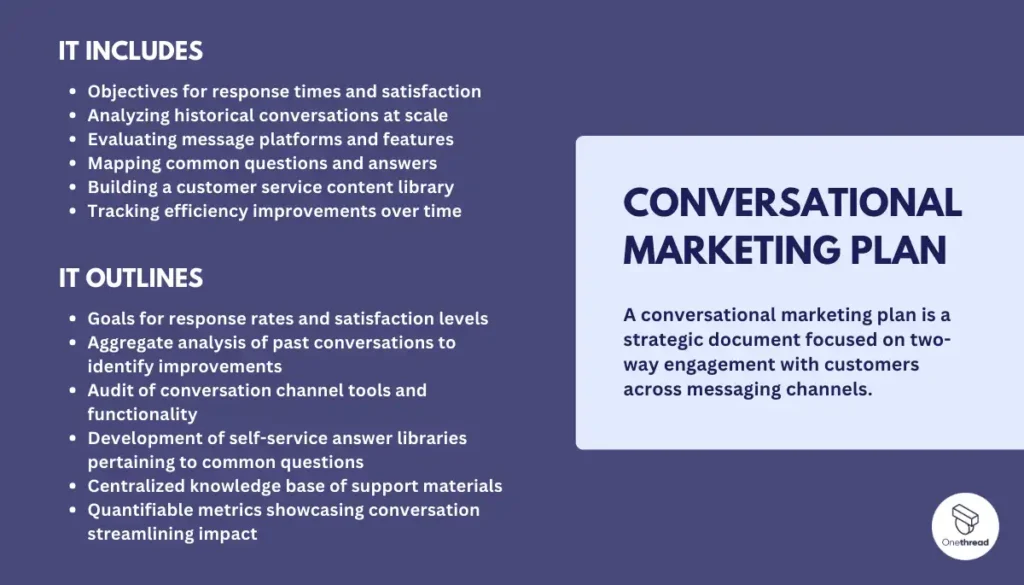
A conversational marketing plan is a strategic document focused on two-way engagement with customers across messaging channels.
The conversational marketing plan includes objectives for response times and satisfaction, analyzing historical conversations at scale, evaluating message platforms and features, mapping common questions and answers, building a customer service content library, and tracking efficiency improvements over time.
It outlines goals for response rates and satisfaction levels, aggregate analysis of past conversations to identify improvements, audit of conversation channel tools and functionality, development of self-service answer libraries pertaining to common questions, centralized knowledge base of support materials, and quantifiable metrics showcasing conversation streamlining impact.
Who Should Create This Marketing Plan And Why?
Businesses looking to improve customer engagement, provide instant support, and personalize the buying experience should adopt conversational marketing. It’s especially effective for companies in industries where quick decision-making is part of the purchase process.
Who Shouldn’t Create This Marketing Plan And Why?
Companies without the technology infrastructure to support real-time communication or those in sectors where the purchase process requires less immediacy might not benefit as much. If the target audience prefers traditional communication channels, conversational marketing may not be the best fit.
SEO Plan
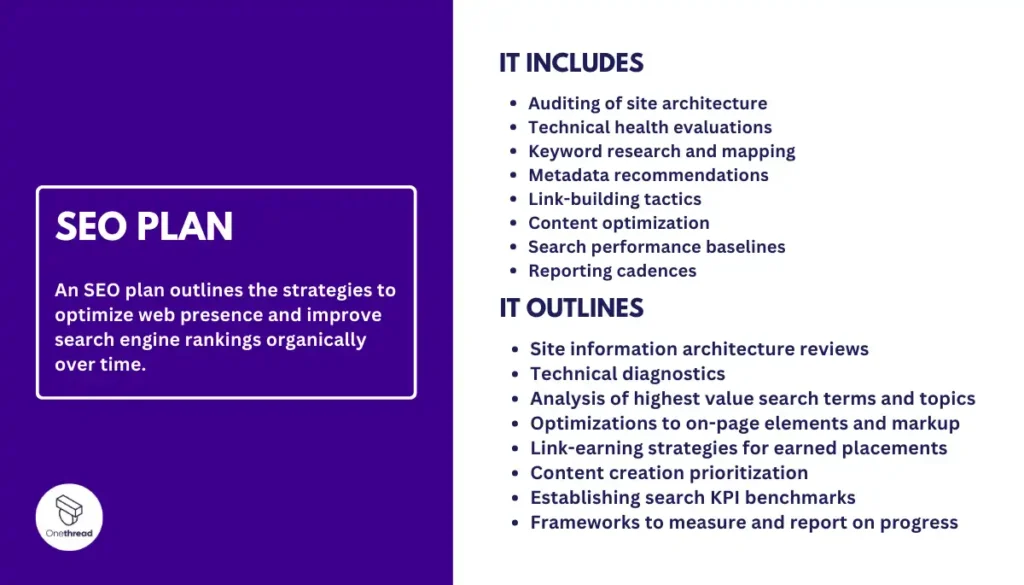
An SEO plan outlines the strategies to optimize web presence and improve search engine rankings organically over time.
The SEO plan includes auditing of site architecture, technical health evaluations, keyword research and mapping, metadata recommendations, link-building tactics, content optimization, search performance baselines, and reporting cadences.
It outlines site information architecture reviews, technical diagnostics, analysis of highest value search terms and topics, optimizations to on-page elements and markup, link-earning strategies for earned placements, content creation prioritization, establishing search KPI benchmarks, and frameworks to measure and report on progress.
A tool that can help with content optimization tasks is an online AI paraphrasing tool. It restructures words for clarity, making your content easy to index by the web crawlers.
Who Should Create This Marketing Plan And Why?
Any business looking to increase its visibility online and attract more traffic through organic search should have an SEO plan, including the hiring of one or two backlink agencies. It’s essential for companies aiming to establish authority in their industry, reduce reliance on paid advertising, and reach customers at the moment they’re searching for related products or services.
Who Shouldn’t Create This Marketing Plan And Why?
Companies in highly competitive industries where SEO investment may not provide a short-term ROI, or those without the capacity to produce consistent, high-quality content, might find SEO challenging. If immediate visibility is required, paid advertising might offer quicker results.
Event Marketing Plan
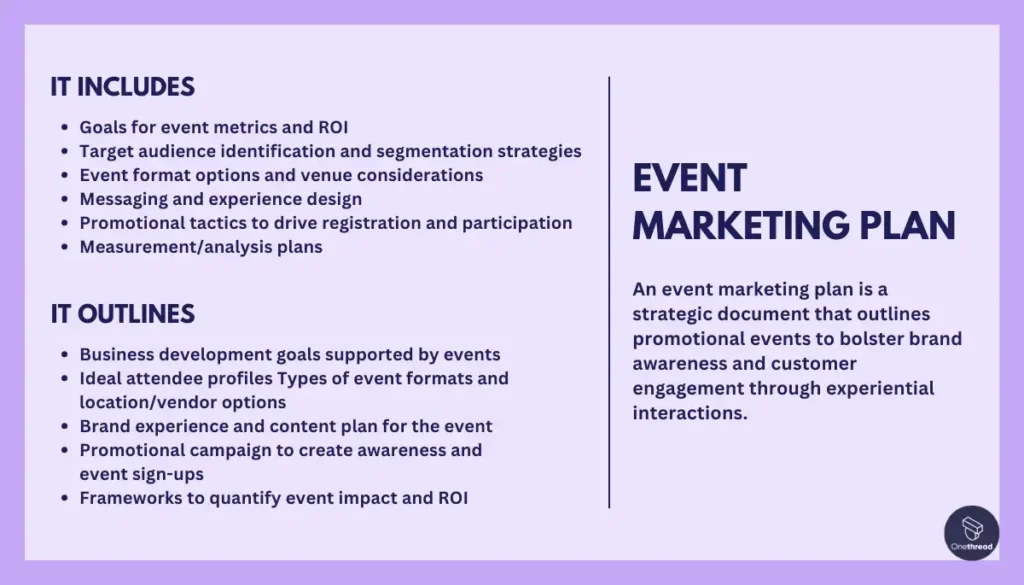
An event marketing plan is a strategic document that outlines promotional events to bolster brand awareness and customer engagement through experiential interactions.
The event marketing plan includes goals for event metrics and ROI, target audience identification and segmentation strategies, event format options and venue considerations, messaging and experience design, promotional tactics to drive registration and participation, and measurement/analysis plans.
It outlines the business development goals supported by events, ideal attendee profiles, types of event formats and location/vendor options, brand experience and content plan for the event, promotional campaign to create awareness and event sign-ups, and frameworks to quantify event impact and ROI.
Who Should Create This Marketing Plan And Why?
Companies looking to build community, enhance customer loyalty, or launch products in an interactive setting should consider an event marketing plan. It’s effective for businesses aiming to create memorable experiences that strengthen brand affinity and facilitate direct interaction with their audience.
Related Article: Best Project Management Software for Event Planning
Who Shouldn’t Create This Marketing Plan And Why?
Businesses without the resources to plan and execute events, or those whose target audience is not geographically concentrated, might find event marketing challenging. If virtual or digital channels offer a more cost-effective way to reach and engage your audience, focusing on those might be preferable.
Inbound Marketing Plan
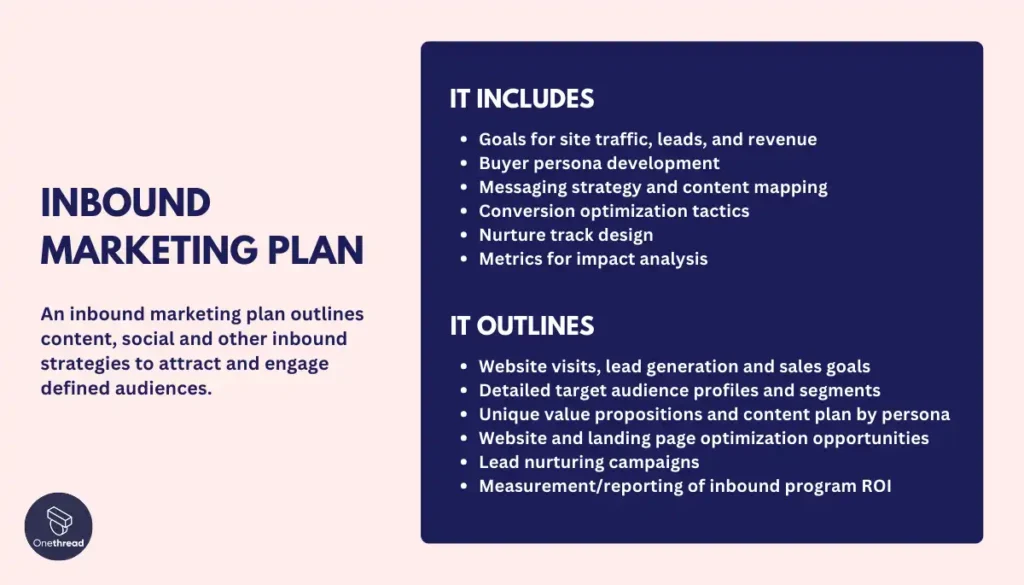
An inbound marketing plan outlines content, social and other inbound strategies to attract and engage defined audiences.
The inbound marketing plan includes goals for site traffic, leads, and revenue, buyer persona development, messaging strategy and content mapping, conversion optimization tactics, nurture track design, and metrics for impact analysis.
It outlines website visits, lead generation and sales goals, detailed target audience profiles and segments, unique value propositions and content plan by persona, website and landing page optimization opportunities, lead nurturing campaigns, and measurement/reporting of inbound program ROI.
Who Should Create This Marketing Plan And Why?
Businesses committed to building long-term relationships with their audience by providing value through content should implement an inbound marketing plan. It’s particularly effective for companies looking to establish thought leadership, improve website traffic, and generate leads organically.
Who Shouldn’t Create This Marketing Plan And Why?
Companies looking for quick sales or those unable to consistently produce relevant, high-quality content may not find inbound marketing effective. If your market is highly competitive or your audience prefers traditional marketing methods, alternative strategies might be more successful.
Each plan starts with core objectives and builds integrated strategies across pricing, distribution, advertising, and other areas to execute the plan and measure ROI. The specific approach depends on your overall business strategy and goals.
Furthermore, the traditional marketing plans may not work for millennials. So, if your target customers are mostly millennials, you need to know how to market toward millennials or Generation Y.
For example, incorporating modern technology such as QR codes in your marketing materials can engage millennials by providing instant access to exclusive content or promotions directly from their smartphones.
Marketing Strategy vs. Marketing Plan
A marketing strategy is the overarching purpose behind your marketing efforts, shaped by your business goals. It defines the solution you offer, its alignment with your company’s mission, and its significance in addressing your prospect’s challenges. It’s the foundation that guides the direction of your marketing activities, focusing on long-term goals and the overall approach to reach your target audience.
A marketing plan, on the other hand, is the execution roadmap of your marketing strategy. It details the tactical marketing efforts—the specific actions, timelines, and resources—needed to achieve your marketing goals.
It encompasses the what, where, when, and how of your strategy implementation, including planned campaigns, budgeting, and metrics for tracking success.
Aspect | Marketing Strategy | Marketing Plan |
Definition | The overarching purpose behind marketing efforts, is focused on long-term goals and an overall approach. | The detailed roadmap of tactical efforts to implement the strategy, including specific actions and timelines. |
Purpose | To align marketing goals with the business’s broader objectives. | To outline the steps needed to realize the strategic marketing goals. |
Focus | Goals, target audience, method of communication, competitor analysis. | Implementation methods, tactical steps, channel strategy, content strategy. |
Outcome | Guides the direction of marketing efforts and decisions. | Specifies the activities, tasks, and resources needed for execution. |
So, these were the basic differences between a marketing plan and marketing strategy. In addition to this, many people confuse between business plan and marketing plan as well. Let’s find out how they differ:
Marketing Plan vs. Business Plan
Marketing Plan is a part of the business plan. A marketing plan is a document that outlines the strategy and tactics a company will use to acquire and retain customers. It focuses specifically on how a business will promote its products or services.
A business plan is a broader document covering all aspects of a company’s operations. There are many components of a business plan, including the marketing plan as well as sections on company overview, financial projections, operations, management team, and more.
In essence:
- A marketing plan is tactical and centers on the marketing strategy and activities.
- A business plan covers the entire business strategy and operations, of which the marketing plan is one component.
While the marketing plan is included in the business plan, it also serves as a standalone document that guides a company’s marketing efforts. But the business plan provides the overarching vision and direction for the whole company.
Here’s a comparison table to highlight their differences:
Aspect | Business Plan | Marketing Plan |
Purpose | Outlines the company's overall goals and strategies. | Focuses on the company's marketing strategy and activities. |
Scope | Broad, covering all aspects of the business. | Specific to marketing efforts. |
Use | Secures funding and guides decision-making. | Guides marketing activities and measures success. |
Contents | Mission, vision, financial projections, organizational structure. | Marketing strategies, target audience, the four Ps, sales strategies. |
Audience | Potential investors, company leadership. | Marketing team, company leadership. |
While both plans aim to support the business’s success, the business plan provides a comprehensive overview, and the marketing plan delves into the specifics of marketing the business effectively.
How Do A Marketing Plan and A Business Plan Work Together?
A marketing plan and a business plan work together like a map and a compass, guiding a business toward its goals. The business plan lays out the overall direction and objectives of the company, including its vision, mission, financial goals, and operational structure. It’s the big picture that shows where the business wants to go.
The marketing plan, on the other hand, focuses on how to attract and retain customers to achieve the sales and revenue objectives outlined in the business plan. It details specific marketing strategies, target audiences, promotional tactics, and budgets. It’s about getting the right message to the right people to turn them into customers.
Together, they ensure that the company’s efforts are aligned and coordinated. The business plan sets the destination, while the marketing plan maps out the route to get there. By working in tandem, they help a business stay on track, efficiently use its resources, and achieve its overarching goals.
How to Write an Effective Marketing Plan?
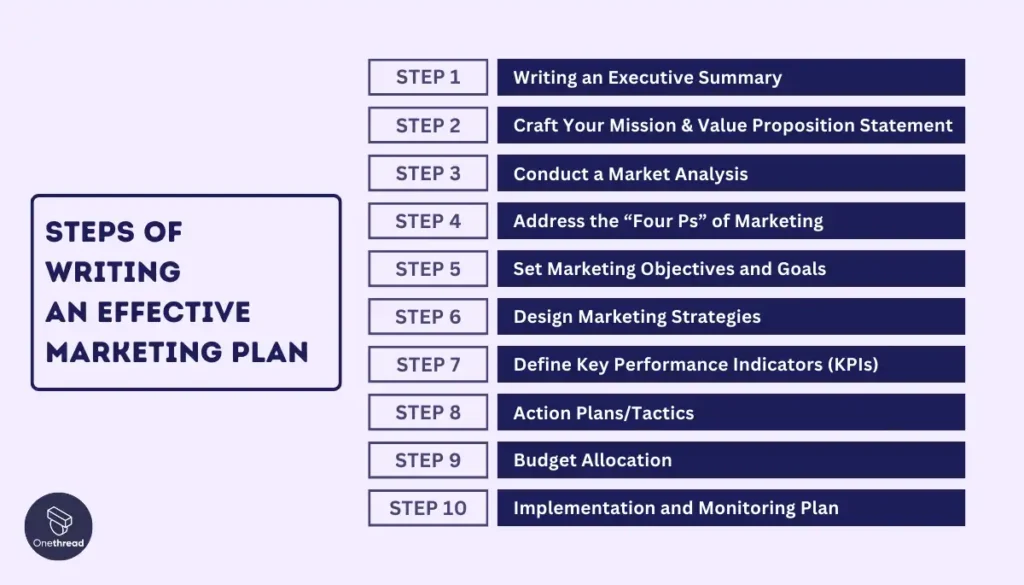
Writing a effective marketing plan helps a business figure out how to tell people about its products or services. Here’s how to do it step by step, in a simple way:
Step 1: Writing an Executive Summary
The executive summary is a short overview at the beginning of a marketing plan, typically 1-2 paragraphs. It should include your key goals, metrics, company background, future plans, and other high-level details that summarize the main points of your full plan. However, it should not get too detailed or provide specifics that will come later in the full plan.
Here’s what you should and shouldn’t include:
- Do include: Key goals, a bit about your company’s background, and a sneak peek into your future plans.
- Don’t include: Deep details or specific figures that you will discuss later in the document.
The executive summary introduces readers to your marketing strategy and gets them interested to read further. It sets the tone and acts as a primer for the rest of the plan. An effective executive summary grabs attention while being concise.
After drafting your full marketing plan, you can come back and write the executive summary to encapsulate all the key pieces into a simplified snapshot upfront. The details and specifics will then be elaborated on in the complete plan that follows.
Step 2. Craft Your Mission & Value Proposition Statement
A mission statement explains why your business exists, what values guide it, and the goals it wants to achieve. It should mention the impact you aim to make but not specific strategies.
A mission statement is like your company’s promise to the world. It tells everyone what you stand for and what you want to accomplish. Here’s how to make a great one:
- Reflect on your purpose: Think about why you started your company and the good you want to do.
- Define your core values: Write down the big beliefs that guide how your company acts.
- Set your goals: Decide what big achievements you’re aiming for.
When writing your mission statement, keep these tips in mind:
- Do keep it short and sweet: Make it easy to remember and inspiring.
- Do make it about the big picture: Focus on your company’s impact and values.
- Don’t get into the nitty-gritty: Leave out the specific methods or plans. That’s for other parts of your business plan.
Your mission statement is a big deal because it’s the heart of your company. It’s not just for you but for everyone who interacts with your business. It helps them understand what you’re all about and why they should care. So, take your time, make it meaningful, and don’t be afraid to change it as your company grows.
Step 3. Conduct a Market Analysis
A market analysis looks at potential customers and competitors. It helps you understand who wants to buy your product and what other companies you’re up against. Don’t include guesses or untested ideas; stick to real data and facts.
In a market analysis, you dive deep into understanding your business environment. This means looking at three big areas:
- Industry analysis: Learn about the business world you’re entering. How big is it? Is it growing or shrinking? Who are the big players?
- Target market analysis: Figure out who will buy your product. What do they like? How old are they? Where do they live?
- Competitive analysis: Find out about the companies you’re competing with. What do they do well? Where could they improve?
Here’s what to do and not to do in your market analysis:
- DOs:
- Use real numbers to talk about your industry and target market.
- Look at both your direct competitors and others who might not be exactly the same but still compete for your customers’ attention.
- DON’Ts:
- Make guesses without data to back them up.
- Ignore smaller competitors or different business models that could disrupt your market.
Your market analysis is like a map for your business journey. It shows you where you’re going, the obstacles you might face, and the opportunities you can grab. This step is crucial because it tells you if your business idea can succeed and how you can make it happen.
Step 4. Address the “Four Ps” of Marketing
This step is about planning your superhero strategy:
- Product: What are you selling? Make sure it meets your customers’ needs.
- Pricing: How much will your product cost? It should be a price that makes sense for your customers and covers your costs.
- Place: Where will you sell your product? Think about the best way to reach your customers.
- Promotion: How will you tell people about your product? Choose the best ways to get the word out.
Step 5. Set Marketing Objectives and Goals
Marketing goals are broad targets like getting more website visits. Objectives are specific and measurable, like increasing site traffic by 20% in six months. Include clear, achievable objectives but don’t include vague or unmeasurable goals.
When setting your marketing objectives and goals, think of goals as your destination and objectives as the steps to get there.
Goals are big and inspirational, like “become the top seller of organic snacks in the Midwest.” Objectives are concrete and actionable, with a clear deadline and a way to measure success, like “increase online sales of organic snacks by 30% in the next year.”
Here’s how to make your marketing goals and objectives work:
- For Goals:
- Align them with your company’s mission statement. This ensures your marketing efforts support the overall purpose of your business.
- Be broad but focused. For example, “Increase brand awareness among health-conscious consumers.”
- For Objectives:
- Use the SMART criteria: Specific, Measurable, Achievable, Relevant, and Time-bound.
- Break down your big goal into smaller, detailed objectives. For example, “Launch a social media campaign targeting health-conscious consumers to gain 10,000 followers in three months.”
Remember, your objectives should directly support achieving your goals. Keep tracking and adjusting both as needed. This way, you’ll not only dream big but also take the right steps to make those dreams a reality.
Detail Your Objectives: Plan Your Path
After you know what you want to achieve, the next step is to get into the details. If your goal is to sell more cookies, how will you do it? Maybe you decide to create fun posts on social media or offer a cookie of the week.
- How to Break It Down:
- Action Steps: List what you’ll do to reach your goals, like posting on social media three times a week.
- Timeline: Set deadlines for when you want to achieve your goals.
- The Reward:
- You have a clear plan to follow, making it easier to achieve your goals.
Using SMART goals means your objectives are clear and reachable. Think about what success looks like and how you’ll know when you get there.
Step 6: Design Marketing Strategies
Designing marketing strategies means planning how to show your products to customers. Include steps like defining your brand and knowing your audience. Don’t include unclear or impossible plans.
Marketing strategies are your game plan for reaching your customers and making them want to buy from you. Think of it as a map that guides you from having a great product to making sure people know about it and want to buy it. Here’s what to focus on:
- Define Your Brand: This is all about what your company stands for. Make sure your ads and products show what’s special about your brand.
- Know Your Audience: Understand who wants your product. Are they young people, parents, or sports fans? This helps you make ads that speak to them.
- Check Out Trends and Competition: Stay updated on what’s in and what other companies are doing. This helps you stay relevant and competitive.
- Choose the Right Channels: This could be social media, emails, or ads on websites. Pick where your customers are most likely to see your stuff.
- Set a Budget: Know how much you can spend and make sure it’s used wisely to reach your goals.
- Measure Success: Use tools to see if your strategy works. If not, be ready to change things up.
Your strategy should be like a recipe that combines all these ingredients in the best way to make your product irresistible to customers. Keep it clear, make sure it matches what your brand is all about, and always be ready to tweak things based on what works best.
Step 7. Define Key Performance Indicators (KPIs)
KPIs are targets used to measure success. They focus on important aspects of business performance. Include specific, measurable goals. Don’t include vague or irrelevant measures.
KPIs help you understand how well your business is doing in reaching its goals. They are like a scoreboard for your business, showing if you’re winning or need to improve. Here’s how to set them up:
- Choose KPIs related to your main goals: If your goal is to increase sales, a KPI could be “increase monthly sales by 10%”.
- Make them SMART: Specific, Measurable, Achievable, Relevant, Time-bound. For example, “grow email subscribers by 500 in 3 months”.
You should:
- Connect KPIs with your business strategy: This ensures every team’s efforts align with broader company goals.
- Regularly review and adjust KPIs: As your business grows and market conditions change, your KPIs should evolve too.
- Avoid too many KPIs: Focus on a few that really matter. This prevents confusion and keeps your team focused on what’s important.
By clearly defining your KPIs, everyone in your team knows what success looks like and can work towards achieving it. This makes it easier to spot areas that need improvement and celebrate when targets are hit.
Step 8. Action Plans/Tactics
Action plans are specific steps to reach your marketing goals. Include tasks, timelines, and who’s responsible. Don’t include vague ideas or actions without deadlines.
Action plans turn your marketing goals into reality. They break down what you need to do when you need to do it, and who will do it. Here’s how to make them work:
- Outline each task: List everything that needs to be done to reach your goals.
- Assign responsibilities: Decide who in your team does what.
- Set deadlines: Give each task a finish date to keep things on track.
You should:
- Be specific: Each action should be clear and direct.
- Monitor progress: Check how things are going regularly.
- Adjust as needed: If something isn’t working, be ready to change your plan.
Good action plans are flexible and clear. They guide your team step by step toward your marketing goals. Make sure your plans are easy to follow and focus on results.
Step 9. Budget Allocation
This step involves deciding how much money to spend on marketing activities. Include costs for each tactic. Don’t ignore unexpected expenses or limit flexibility.
Budget allocation is like planning how much money to spend on a shopping trip. You need to know what you want to buy (your marketing activities) and how much each item costs (the expenses for each tactic). Here’s what to do:
- List all your marketing activities: For example, social media ads, email marketing, and billboards.
- Estimate the cost for each activity: Find out how much money you need for each part of your plan.
You should:
- Set aside money for surprises: Sometimes things cost more than you expect. Save some of your budget just in case.
- Be ready to move money around: If one activity is working really well, you might want to spend more on it.
Having a clear budget helps you spend your money wisely. It makes sure you have enough for all the things you want to do without running out.
Step 10. Implementation and Monitoring Plan
This step is about putting your marketing plan into action and keeping an eye on how it’s doing. It involves starting the marketing activities and checking their progress.
To bring your marketing plan to life, you need to do a few important things:
- Start the activities: Get all the parts of your marketing plan going. This might include posting on social media, sending out emails, or putting ads online.
- Check on things regularly: Keep an eye on how these activities are going. Are people visiting your website? Are they buying your product? This is called monitoring.
You should include:
- A schedule: When will each part of your plan start and finish?
- Who is responsible: Who will do each task?
- Tools you’ll use: What software or tools will help you keep track of everything?
Don’t include:
- Unrealistic goals: Make sure what you’re planning to do is possible.
- Vague tasks: Be clear about what each task involves so everyone knows what to do.
Having a plan for action and monitoring means you can make sure your marketing is doing what you want it to do. If something isn’t working, you can change it. This way, you can get better results and help your business grow.
Let’s look at some examples of marketing plans to see how different businesses plan to reach their customers and sell their products or services. Remember, a marketing plan is like a recipe for how a business can attract and keep customers.
Example of a Marketing Plan
Here are eight commonly discussed examples of marketing plans that you can model and modify for your own use:
Visit Baton Rouge Marketing Plan Example
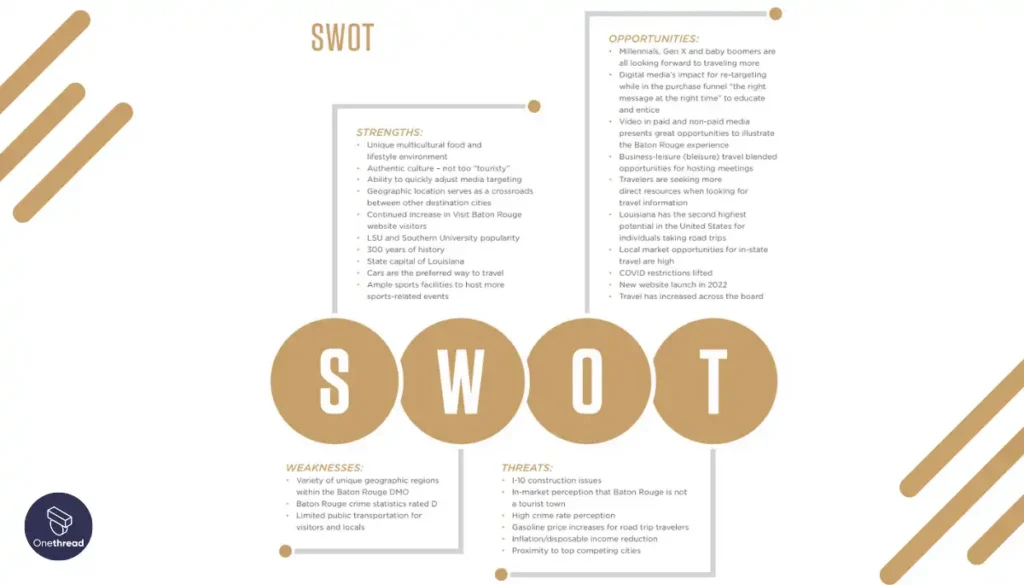
The Visit Baton Rouge Marketing Plan is designed to boost awareness and visitation to the Greater Baton Rouge area.
It’s a comprehensive strategy that includes situational analysis, SWOT analysis, identification of the target audience, setting overall goals, and detailed plans for leisure marketing, meetings, and conventions marketing, destination sales, and services, special projects, and events.
An event calendar and recommended evaluation methods ensure the plan’s effectiveness and adaptability.
How It Works:
The plan operates by dissecting Baton Rouge’s market environment and potential, defining clear objectives, and deploying targeted marketing strategies across different segments.
It leverages Baton Rouge’s unique offerings, focusing on leisure, meetings, and conventions to attract diverse visitor demographics. Special projects and events, coupled with effective sales and service strategies, play crucial roles in enhancing the city’s appeal.
Why It Works:
This marketing plan is effective due to its comprehensive and strategic approach to understanding and targeting potential visitors. By conducting a thorough situational and SWOT analysis, the plan ensures that strategies are built on solid foundations.
It works by aligning marketing efforts with the city’s strengths and opportunities, ensuring that all actions are targeted, measurable, and tailored to meet the defined goals. The inclusion of a detailed event calendar and evaluation methods ensures that the plan remains dynamic and responsive to market changes
Naperville Park District Strategic Marketing Plan Example
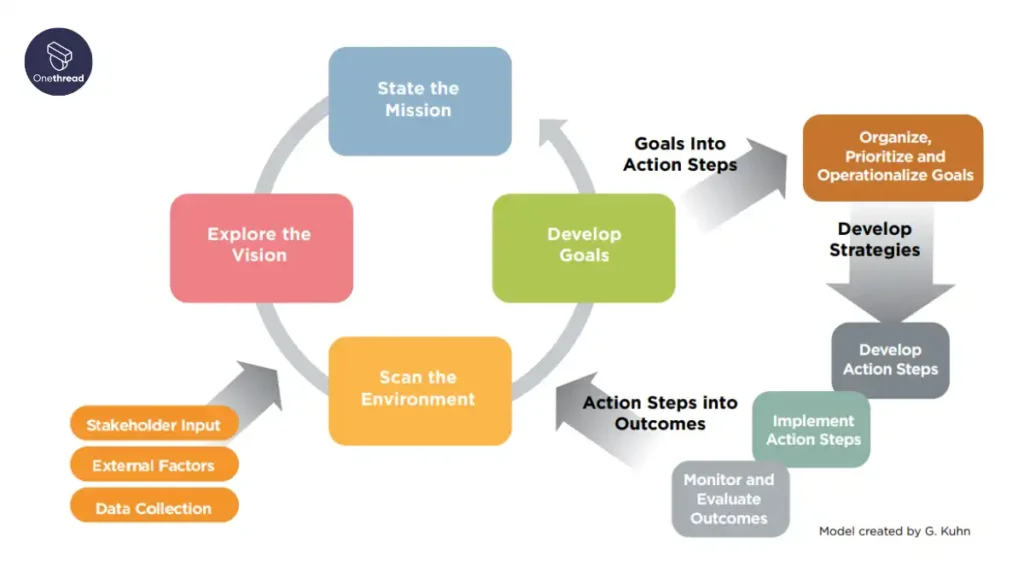
The Naperville Park District Strategic Marketing Plan spans multiple departments to promote a consistent brand image and increase revenue.
Outlined sections include an introduction, situational analysis, marketing and financial objectives and goals, detailed marketing strategies and tactics, public relations plan, budget challenges, and a conclusion. This cross-departmental plan allows Naperville to strategically align its marketing efforts for greater efficiency and impact.
How It Works:
This plan starts by analyzing the market and identifying growth opportunities. It sets measurable marketing goals and details promotional strategies across various media channels. The plan also outlines PR and community outreach plans while examining budget limitations. Recommendations and next steps are provided to ensure a clear path forward.
Why It Works:
The effectiveness of the Naperville Park District’s plan stems from its strategic alignment across departments, ensuring a cohesive marketing effort. Actionable strategies and tactical plans leverage a blend of marketing channels and approaches. Community-building through PR and transparency around budget constraints further strengthen the plan. A clear, forward-moving path with defined strategies and goals ensures the plan’s success in promoting the Park District and enhancing its brand image.
Wisconsin Public Library Systems Marketing Plan Example
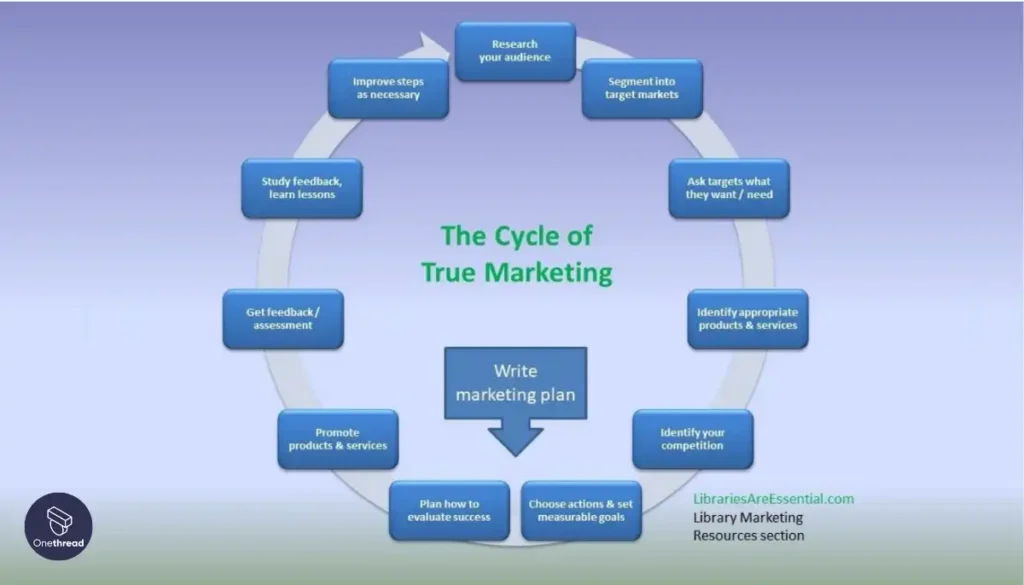
The Wisconsin Public Library Systems Marketing Plan Template offers libraries a customizable framework to strategically plan, execute, and monitor marketing activities.
Key sections include research, segmentation, messaging, strategies, execution, evaluation cycles, and conclusions. This step-by-step process empowers libraries to connect offerings to community needs.
How It Works:
This plan starts with researching patron needs to define target user groups and craft campaign messaging. Promotional channels are planned for executing marketing activities, with feedback gathered to refine the approach continuously. The step-by-step process ensures libraries can effectively reach and engage their audience.
Why It Works:
The plan’s success comes from its patron-centric model, allowing for custom messaging and ongoing refinement of strategies. By combining various promotional strategies with a systematic evaluation process, libraries can maintain a sustainable approach to marketing. This ensures that library offerings remain aligned with community needs, making the plan both effective and adaptable.
Agricultural Extension Service Marketing Plan Example
The Agricultural Extension Service Marketing Plan example walks through developing a successful plan using a hypothetical farm products business.
Outlined sections include research, objectives, strategies, budget, response monitoring, and a checklist. This guides agricultural businesses through tactical promotions rooted in thorough market analysis.
How It Works:
This plan begins with researching customer needs and market dynamics to set quantifiable goals. It details both online and offline marketing tactics, defines budgets and timelines, and tracks campaign responses. This ensures that promotional efforts are well-informed and strategically aligned with business objectives.
Why It Works:
The effectiveness of this marketing plan is rooted in its data-driven decision-making process and the establishment of measurable objectives. By employing a multi-channel approach and maintaining transparency around budgeting, the plan facilitates effective performance benchmarking. The comprehensive checklist further aids in ensuring that all marketing activities are systematically executed and evaluated for ongoing improvement.
University Of Illinois Marketing Plan Example

The University of Illinois Marketing Plan offers a strategic overview of initiatives to increase student interest and admissions.
Outlined sections provide context on admissions funnels, upcoming market research efforts, objectives, detailed marketing programs, and success metrics. This data-driven plan allows the University to connect messaging to key student segments more effectively.
How It Works:
The plan begins by analyzing stages of the enrollment funnel and conducting further research on student demographics. Specific goals for student outreach are set, with messaging and promotions tailored by student segment. Performance is benchmarked using indicators to measure the success of various initiatives.
Why It Works:
This marketing plan’s effectiveness stems from leveraging detailed knowledge of the admissions funnel and incorporating extensive market research. By segmenting the audience strategically and customizing marketing tactics, the University can directly address the interests and needs of potential students.
Trackable objectives and Key Performance Indicators (KPIs) ensure that efforts are focused and results are measurable, facilitating ongoing refinement and optimization of strategies.
Massachusetts Small Business Development Center Network Marketing Plan Example
The Massachusetts Small Business Marketing Plan provides an outline for small business owners to promote their companies effectively.
Key sections include mission, diagnosis, products/services, market analysis, distribution, promotions, competition, and an action plan. This framework turns marketing analysis into an organized blueprint for SMB growth.
How It Works:
The plan starts by defining the business purpose and offerings, and assessing the company’s position in the market. It then researches target customers and markets, plans routes to market, strategizes promotional campaigns, and examines the competitor landscape. This comprehensive approach ensures that every aspect of the marketing strategy is aligned with the business’s goals and the market environment.
Why It Works:
Its effectiveness comes from the alignment with the company’s mission, thorough diagnosis of the current situation, and a clear understanding of product-market fit. By considering multi-channel distribution and targeted promotions, the plan addresses competitive differentiation and outlines a strategic action plan.
This methodical approach allows small businesses to leverage their unique strengths, optimize resources, and navigate the competitive landscape effectively, setting a clear path for growth and success.
ProfitWorks Small Business Marketing Plan Example
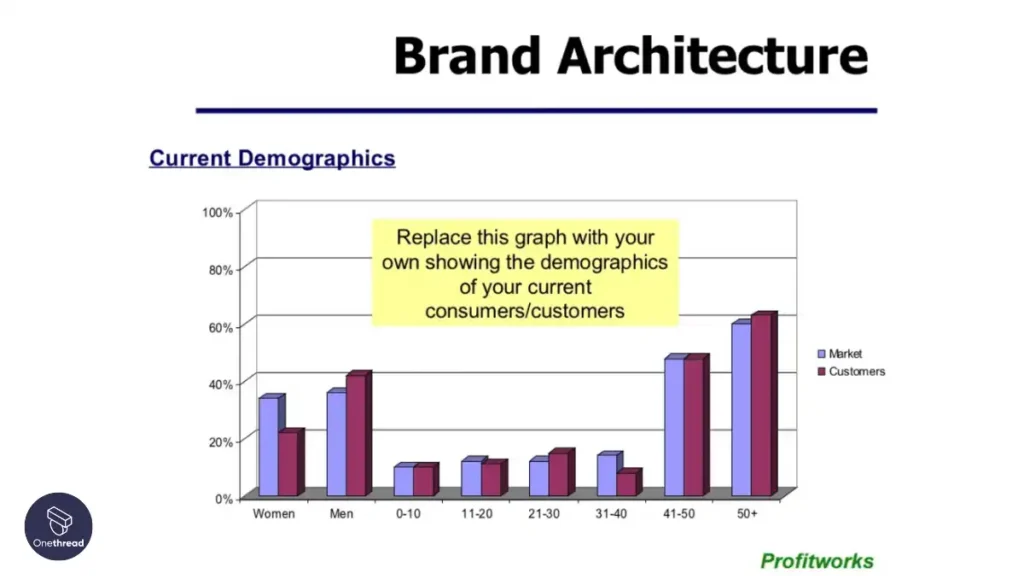
The ProfitWorks Small Business Marketing Plan template assists SMBs in strategizing positioning, products, pricing, distribution, and promotions.
Key sections include current customer demographics, target markets, brand positioning, products/services, pricing models, distribution channels, and promotional tactics. This guides small businesses in aligning strategies to audience needs.
How It Works:
This template begins with an evaluation of existing branding and customer profiles to pinpoint ideal target markets. It then refines product or service offerings, establishes competitive pricing, selects optimal distribution channels, and plans a comprehensive promotional mix. The process is designed to ensure that marketing strategies are closely aligned with audience needs and business objectives.
Why It Works:
The template’s effectiveness lies in its ability to optimize brand elements and focus on data-driven audience targeting, ensuring a product-market fit. The inclusion of competitive pricing strategies and omnichannel distribution plans allows for a cohesive approach to market engagement.
Integrated promotions further enhance the ability to reach and resonate with the intended audience. By providing a structured framework, the ProfitWorks template enables SMBs to align their marketing efforts with strategic goals, facilitating growth and market penetration.
Business.com Small Business Marketing Plan Example
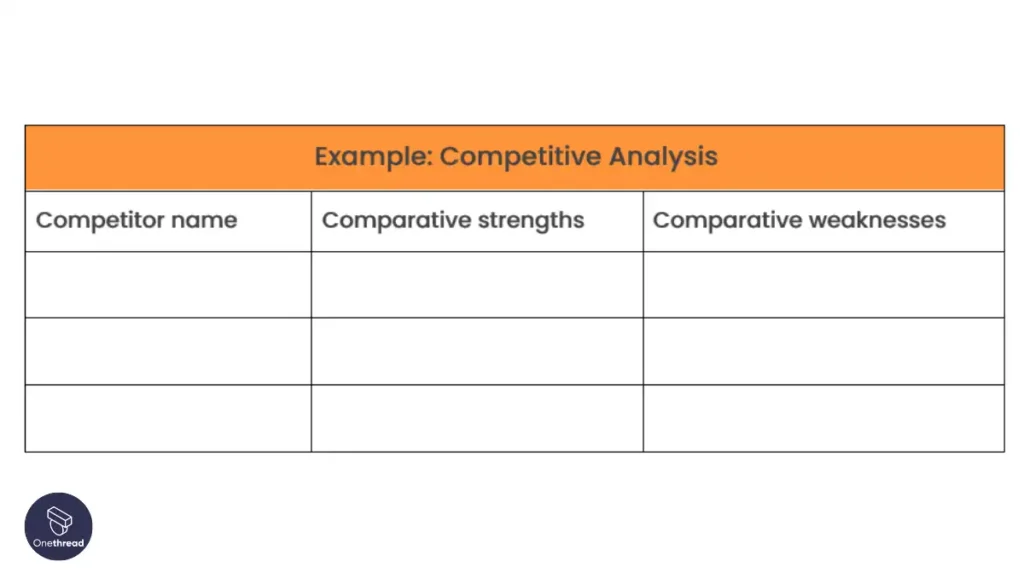
The Business.com Small Business Marketing Plan template allows SMBs to outline strategies by filling in proprietary templates.
Sections include executive summaries, company overviews, target markets, go-to-market strategies, marketing goals, action plans, budgets, tools, and resources. This interactive plan turns templates into an actionable roadmap.
How It Works:
This template facilitates the process by pre-formatting foundational summaries and standardizing the sales process planning. It helps in analyzing target customers and capturing measurable marketing goals.
Tactical campaigns are scheduled, and budgets are outlined, along with curating a list of helpful assets and resources. This structured approach ensures that businesses have a clear plan of action for their marketing efforts.
Why It Works:
The effectiveness of this template is due to its built-in frameworks and customizable templates, which integrate sales processes with marketing strategies. Quantifiable objectives ensure that marketing efforts can be measured and adjusted as necessary.
The documented game plan provides clarity on budget allocation and resources, helping SMBs to navigate their marketing activities with a clear direction and focus on achieving their business goals.
Each of these examples shows a different way to reach out to people and make them interested in what the business offers. By following a plan, businesses can focus their efforts and use their resources wisely to achieve their goals.
Free Marketing Plan Template
Creating a marketing plan can seem tough, but with the right template, it’s like filling in the blanks on a worksheet. Here are some templates to help any business get its marketing plan down on paper, making it easier to understand and follow.
1. Basic Marketing Plan Template
- What’s Inside: This template covers the basics. It has sections for the business’s goals, target audience, marketing strategies, budget, and a schedule of activities. It’s perfect for small businesses or anyone new to marketing.
Download: Doc, Word, Open Document
- How to Use: Fill in each section with your plans. For example, write down who you want to sell to and how you plan to tell them about your product.
2. Digital Marketing Plan Template
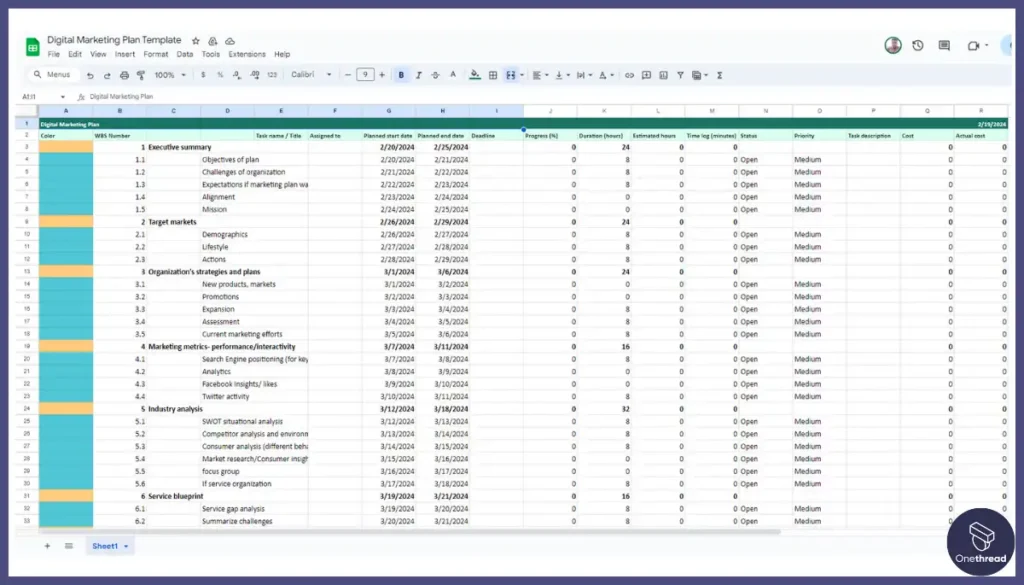
- What’s Inside: This one is for businesses focusing on online marketing. It includes plans for social media, email marketing, SEO (search engine optimization), and online ads.
Download: PDF, Excel, Open Document, Google Sheet
- How to Use: Write down which online platforms you’ll use, what kind of content you’ll share, and how much money you can spend on online ads.
3. Social Media Marketing Plan Template
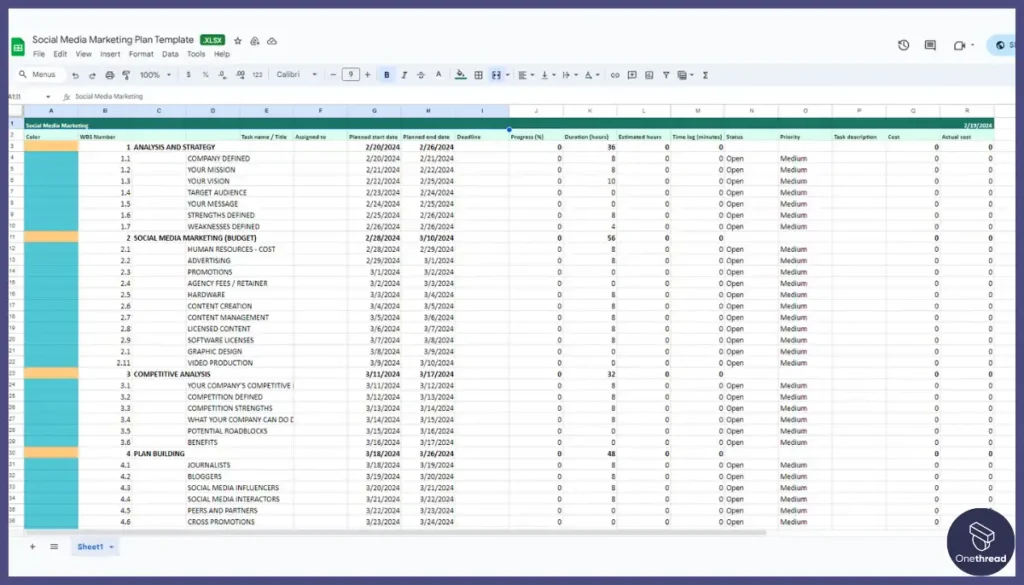
- What’s Inside: It’s all about social media. This template helps you plan your posts, decide which social media channels to use, and track your growth.
Download: PDF, Excel, Open Document, Google Sheet
- How to Use: Choose which social media sites you want to use (like Instagram, Facebook, or Twitter) and plan out what you’ll post each week or month.
4. Event Marketing Plan Template
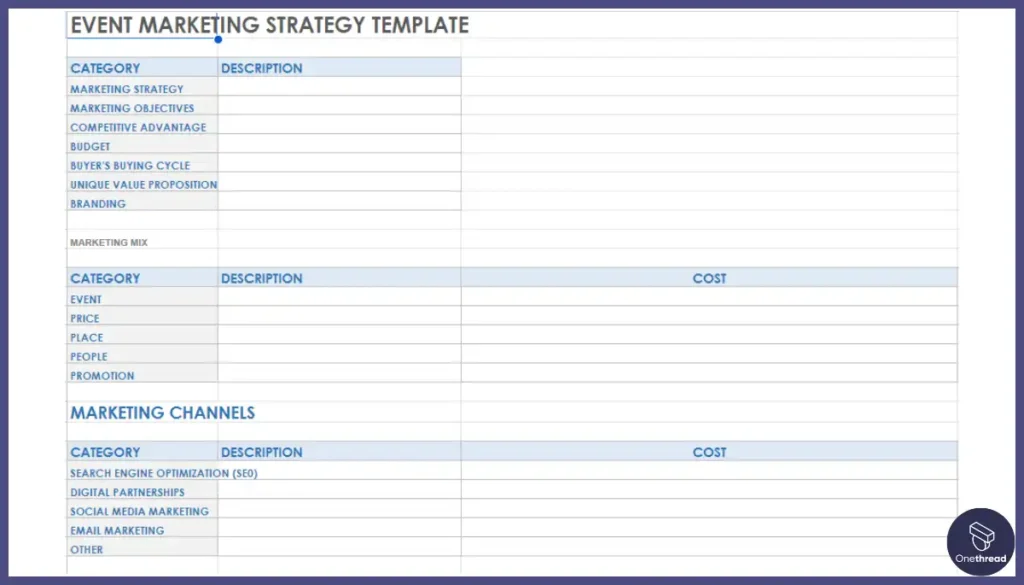
- What’s Inside: This template is for planning marketing activities around a specific event, like a sale, workshop, or grand opening.
Download: PDF, Excel, Google Sheet, Open Document
- How to Use: Plan out how you’ll tell people about the event, what kind of promotions you’ll offer, and how you’ll follow up with attendees afterward.
5. Content Marketing Plan Template
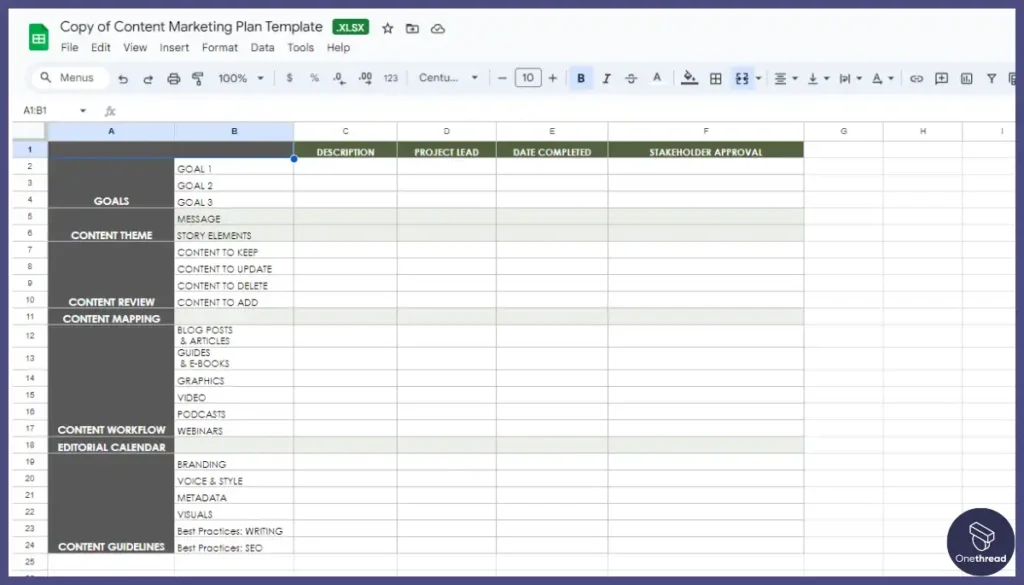
- What’s Inside: It focuses on creating and distributing valuable content to attract and engage a clearly defined audience.
Download: PDF, Excel, Google Sheet, Open Document
- How to Use: Map out the types of content you’ll create (blogs, videos, infographics), where you’ll share it (your website, social media), and how often.
6. Annual Marketing Plan Template
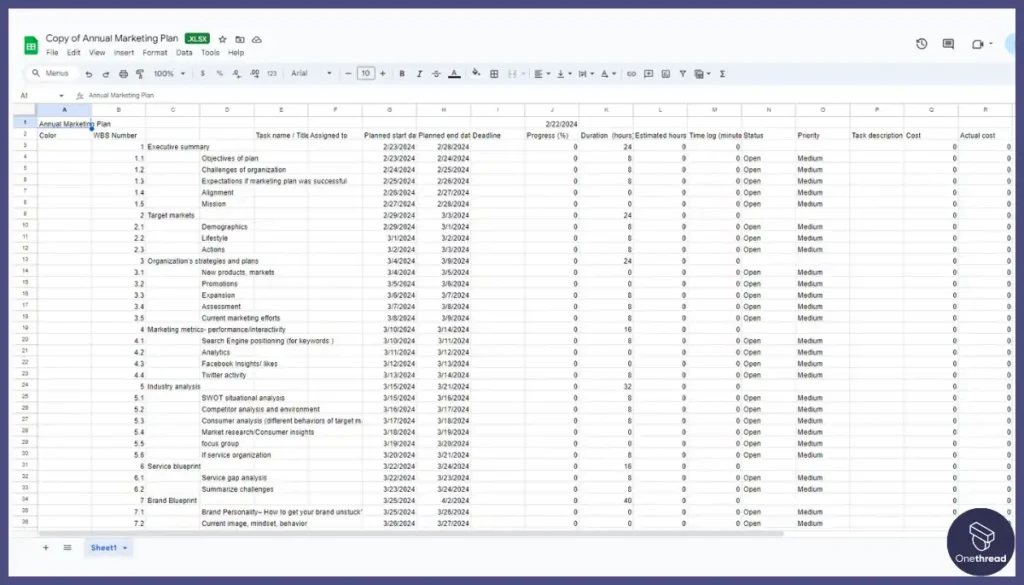
- What’s Inside: This is a big-picture template for the whole year. It helps you set long-term goals and outline strategies for reaching them over 12 months.
Download: PDF, Excel, Google Sheet, Open Document
- How to Use: Break down your yearly goals into smaller, manageable tasks, decide when to do each one, and figure out how much money to allocate.
Each template is like a guidebook for your marketing journey, helping you stay on track and reach your destination successfully. Pick the one that fits your needs, fill it out with your ideas, and start making your marketing plan come to life!
How to Implement a Marketing Plan Effectively?
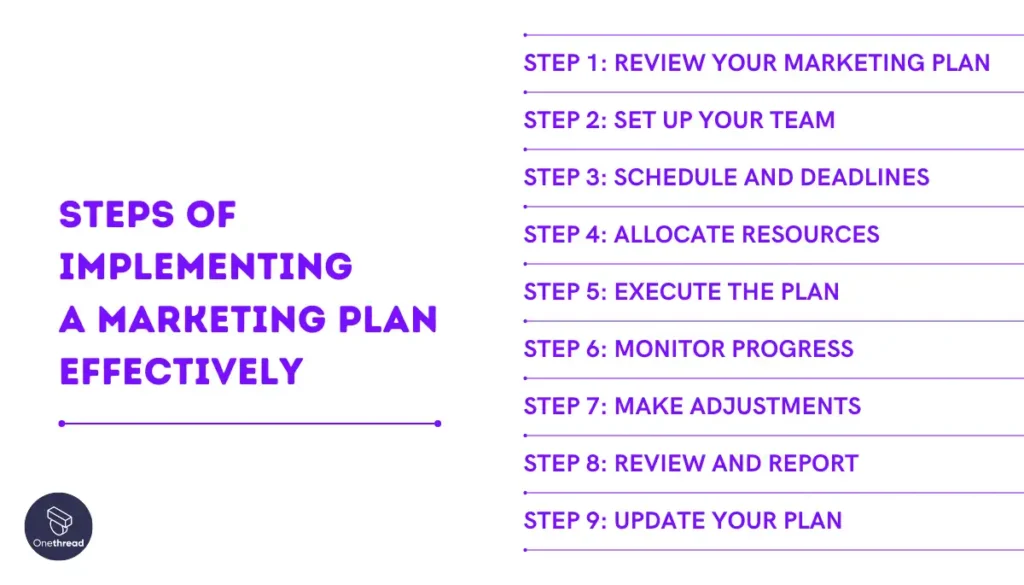
Implementing a marketing plan effectively is like following a recipe for your favorite dish. You need the right ingredients, steps, and timing to make sure everything turns out just right. Here’s how to do it, step by step:
Step 1: Review Your Marketing Plan
- What to Do: Go over your marketing plan carefully. Understand every part of it, from your goals and target audience to your strategies and budget.
- Why It Matters: This ensures everyone involved knows what the plan is and what you’re trying to achieve.
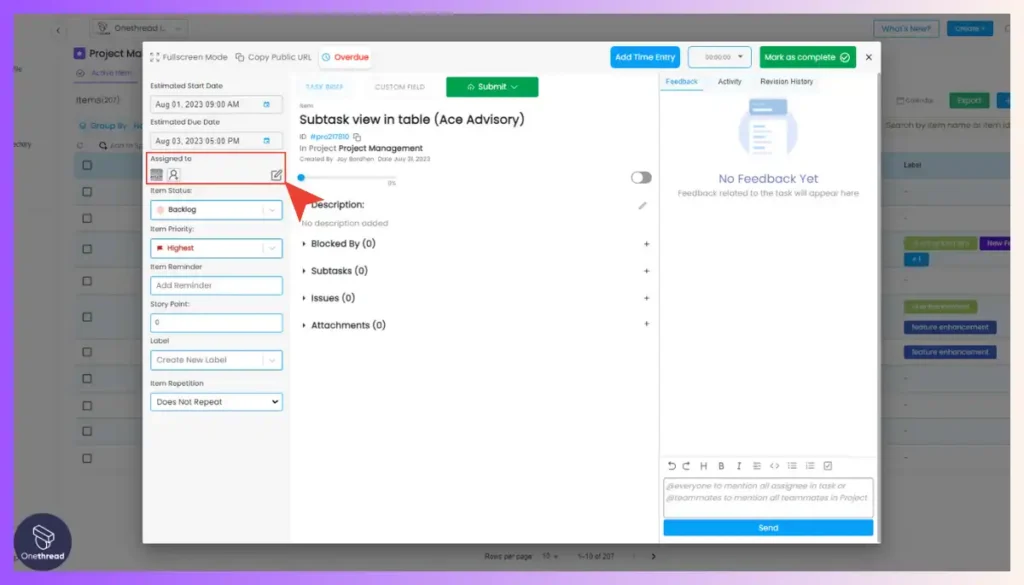
Streamline your marketing plan review with Onethread. This project management software allows you to collaborate with your team, assign tasks, and track progress towards your marketing goals. By centralizing your plan in Onethread, everyone involved can easily access it, understand their roles, and contribute to its success.
Step 2: Set Up Your Team
- What to Do: Decide who will do what. Assign tasks based on your team members’ strengths and skills.
- Why It Matters: Everyone should know their responsibilities to work efficiently and avoid confusion.
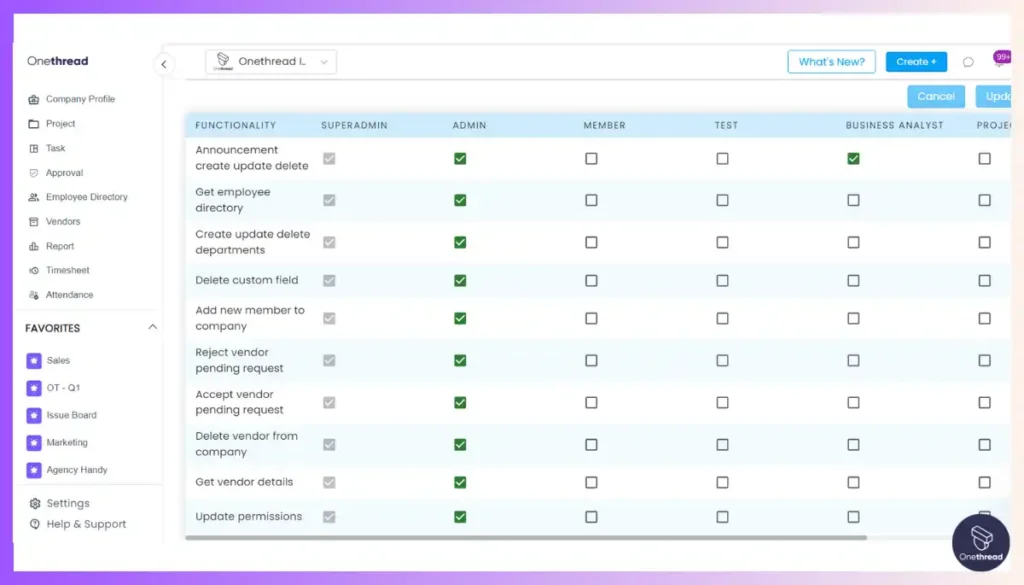
Onethread’s role-based permissions and task management features can help you effectively assign tasks and ensure each team member has clear ownership and deadlines. This promotes accountability and keeps your marketing plan moving forward smoothly.
Step 3: Schedule and Deadlines
- What to Do: Create a timeline. Mark down when each task should start and finish.
- Why It Matters: This keeps your plan on track and ensures that marketing activities happen at the best time.
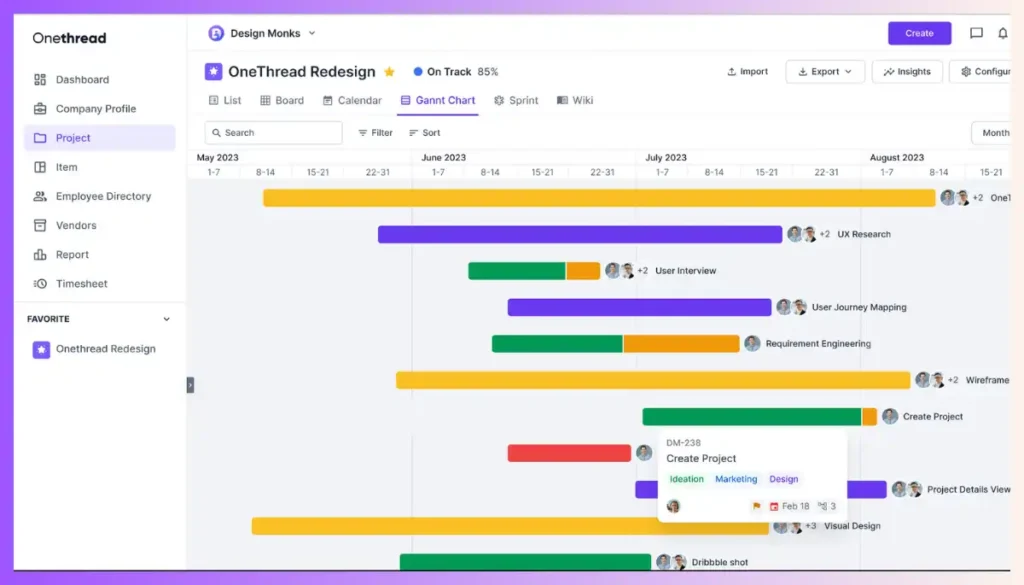
Onethread’s calendar view and Gantt chart features provide a visual representation of your marketing plan timeline. This allows you to easily track deadlines, identify potential bottlenecks, and adjust your schedule as needed.
Step 4: Allocate Resources
- What to Do: Make sure you have everything you need to carry out the plan, like money, tools, and people.
- Why It Matters: Having all your resources ready prevents delays and problems later on.
Step 5: Execute the Plan
- What to Do: Start doing the tasks in your plan. Follow your schedule and use your resources as planned.
- Why It Matters: This is where your plan comes to life. Doing it right can help you reach your goals.
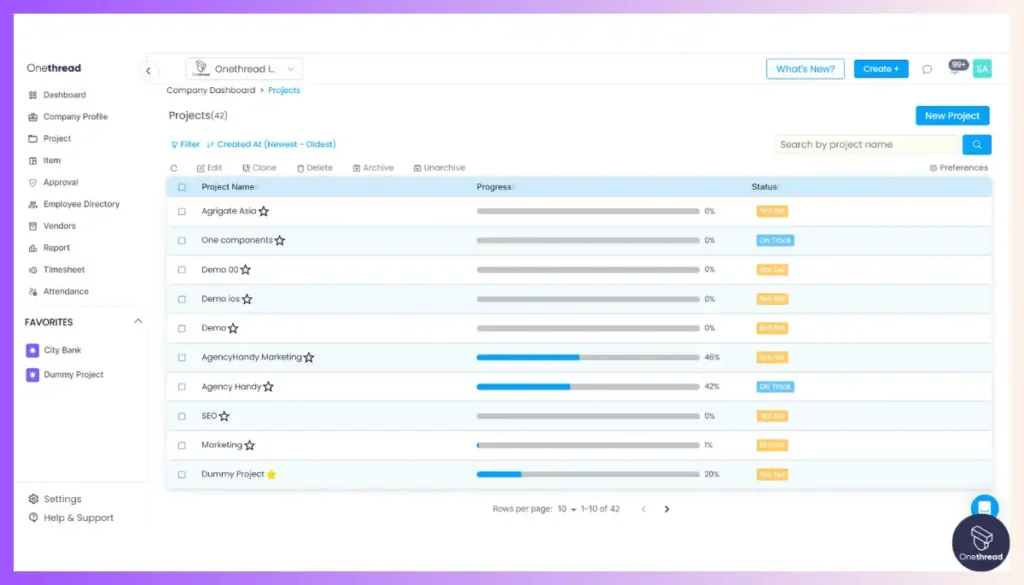
Onethread empowers your team to execute your marketing plan effectively. Assign tasks to specific team members, set due dates, and track progress in real-time. Utilize Onethread’s communication features to keep everyone informed and collaborate seamlessly throughout the execution phase.
Step 6: Monitor Progress
- What to Do: Keep an eye on how things are going. Use your Key Performance Indicators (KPIs) to measure success.
- Why It Matters: Monitoring helps you see what’s working and what’s not. You can fix problems quickly.
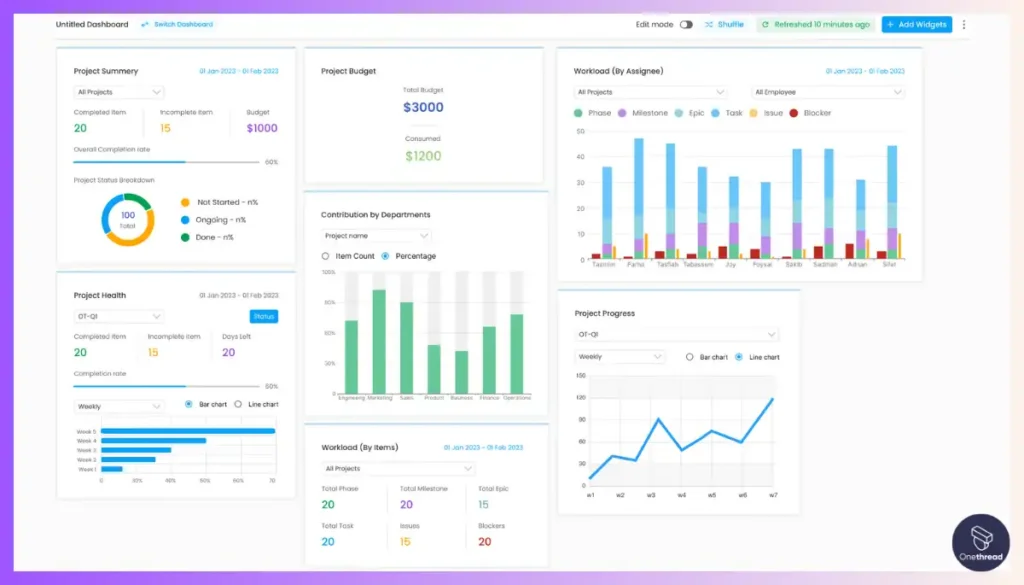
Onethread’s insightful analytics dashboards provide real-time data on your marketing campaign performance. You can track key metrics, identify areas for improvement, and make data-driven decisions to optimize your marketing efforts.
Step 7: Make Adjustments
- What to Do: If something isn’t working, change it. Update your strategies based on what you learn from monitoring.
- Why It Matters: Being flexible allows you to improve your plan and get better results.
Step 8: Review and Report
- What to Do: At the end of your plan’s timeline, look back at what you did and how it worked. Share the results with your team and stakeholders.
- Why It Matters: Reviewing helps you understand what was successful and what could be better next time.
Onethread facilitates a seamless review and reporting process for your marketing plan. Utilize its collaboration tools to gather feedback from your team and stakeholders, and leverage its reporting functionalities to create insightful presentations that showcase your campaign’s performance. This streamlines the process and ensures everyone is on the same page moving forward.
Step 9: Update Your Plan
- What to Do: Use what you learned to update your marketing plan for the future.
- Why It Matters: Continuous improvement helps you adapt to changes in the market and keep growing.
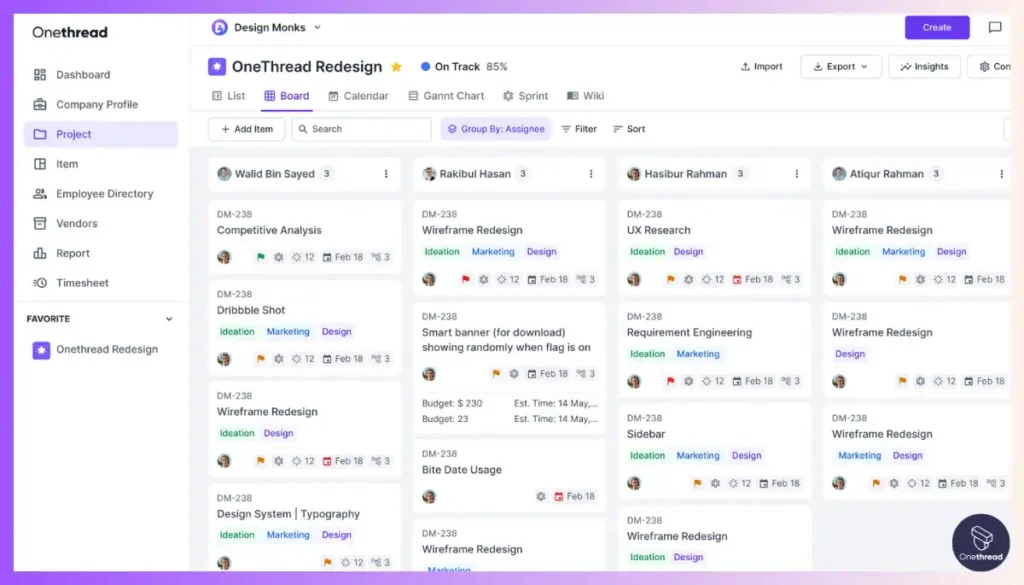
Onethread’s flexible platform allows you to easily update your marketing plan based on your learnings and analysis. Utilize its features like project templates and task management to adapt your strategy, assign new tasks, and adjust timelines as needed. This ensures your marketing plan remains dynamic and responsive to market changes, helping you stay ahead of the curve and achieve sustained success.
[INSERT_ELEMENTOR id=”12410″]
Following these steps can help you implement your marketing plan effectively, leading to better performance and more success for your business.
FAQs
What Is A 5 Point Marketing Plan?
A 5 point marketing plan includes defining your target audience, setting clear objectives, devising a strategy, executing tactics, and measuring results. It’s a concise framework for organizing marketing efforts.
What Are The 7 C’s Of Marketing?
The 7 C’s of marketing are Customer, Cost, Convenience, Communication, Content, Consistency, and Computational. These elements help businesses focus on customer needs and effective marketing strategies in the digital age.
What Are The 7 Of Digital Marketing?
The 7 of digital marketing are Search Engine Optimization (SEO), Pay-per-Click (PPC), Social Media Marketing, Content Marketing, Email Marketing, Mobile Marketing, and Marketing Analytics. These strategies enhance online presence and engagement.
Closing Words
Crafting a comprehensive marketing plan is the key to unlocking business growth and success in the competitive marketplace. By meticulously planning and executing marketing strategies that resonate with target customers, businesses can effectively use their resources to achieve measurable results.
Whether you’re launching a new product or aiming to expand your market reach, a well-thought-out marketing plan is your blueprint to success.
